Lodging an application - contested
Updated 23 April 2025
1. Before you start
This guide is for applicant solicitors. Before you can access financial remedy services using MyHMCTS, you and your organisation must have completed other steps.
1. Set up an HMCTS Payment by Account (PBA) (so that you can pay any relevant fees)
2. Registered your organisation with MyHMCTS
3. Set up your MyHMCTS user account
The MyHMCTS guidance has further information and instructions. If your organisation has an account already, contact the administrator to arrange for your individual user account creation.
Once you have a MyHMCTS account, you can sign in using your email address and password.
You can issue applications online for cases regarding:
- divorce
- civil partnership
- judicial separation and nullity
- maintenance pending suite applications
The application must follow the rules in FPR 2010 Practice Direction 36N.
The fee must be paid for by PBA or an application for help with fees.
2. The case list
When you sign into MyHMCTS you are presented with the ‘Case List’ where you can:
1. View applications you have issued.
2. Create new applications.
3. Move easily between divorce cases and financial remedy applications using the filters.
4. Search for cases, use the ‘Find case’ link at the top right of the screen. Search using the divorce case number, party names or the solicitor reference.
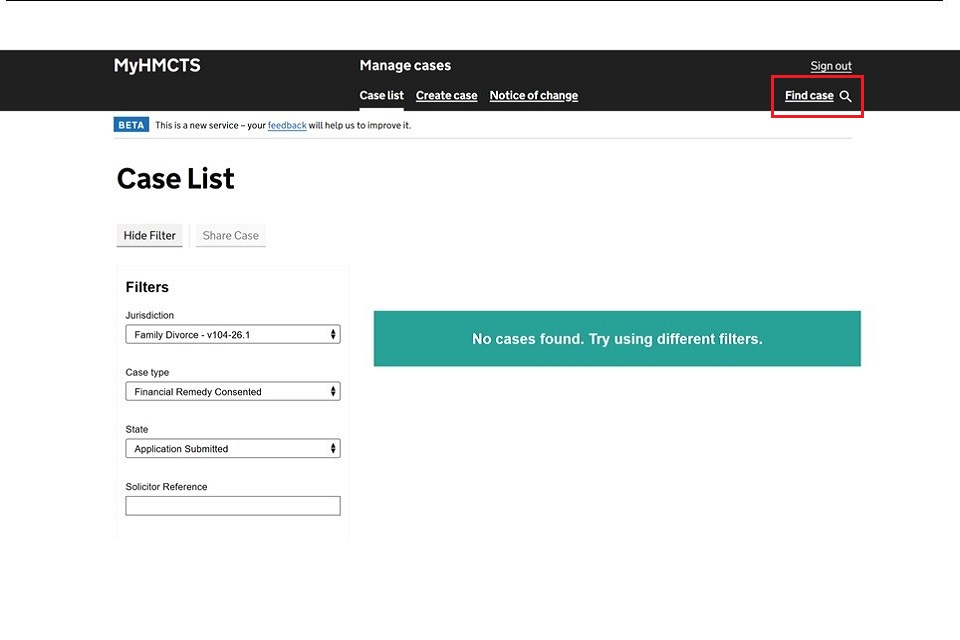
3. Create and submit an application
1. Select ‘Create case’ at the top of your case list page.
2. Choose:
- Jurisdiction – family divorce
- Case type – contested financial remedy
- Event – form A application
3. Select ‘Start’.
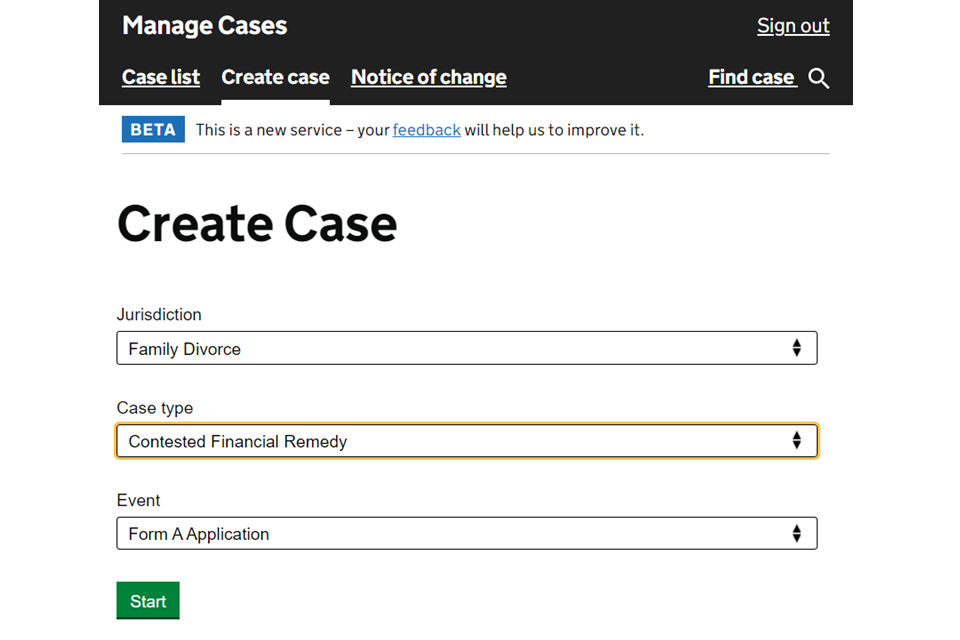
4. Applicant solicitor details
1. Enter the solicitor’s name for the applicant.
2. Search for your organisation using the name or postcode.
3. If the search box fails to find your organisation or shows an error, you should contact MyHMCTSSupport@justice.gov.uk for help.
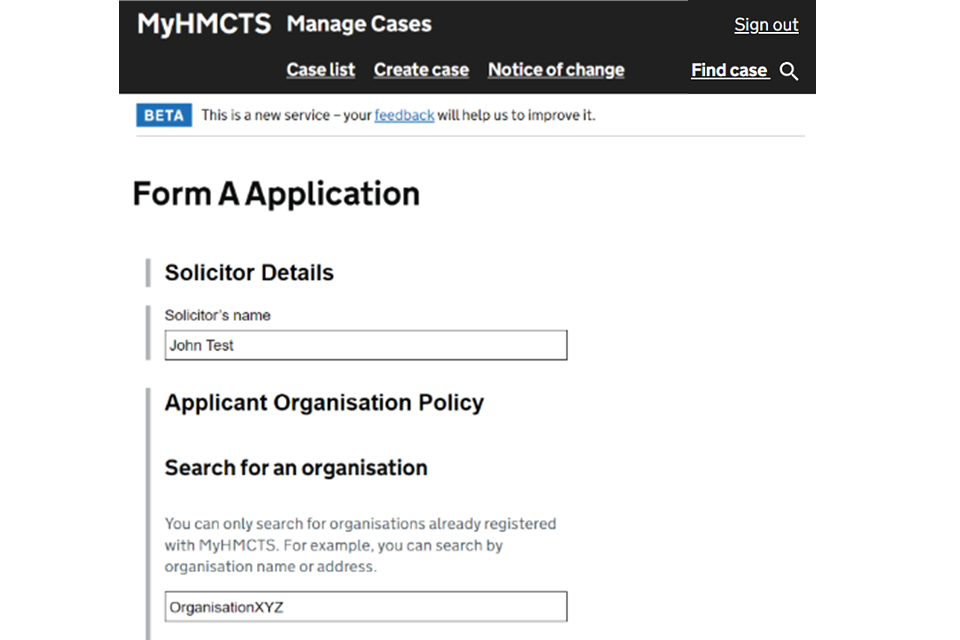
4. Once you have found the correct address for your organisation, choose ‘Select’. If you do not select your organisation, you will not be able to access the case once you have submitted the application.
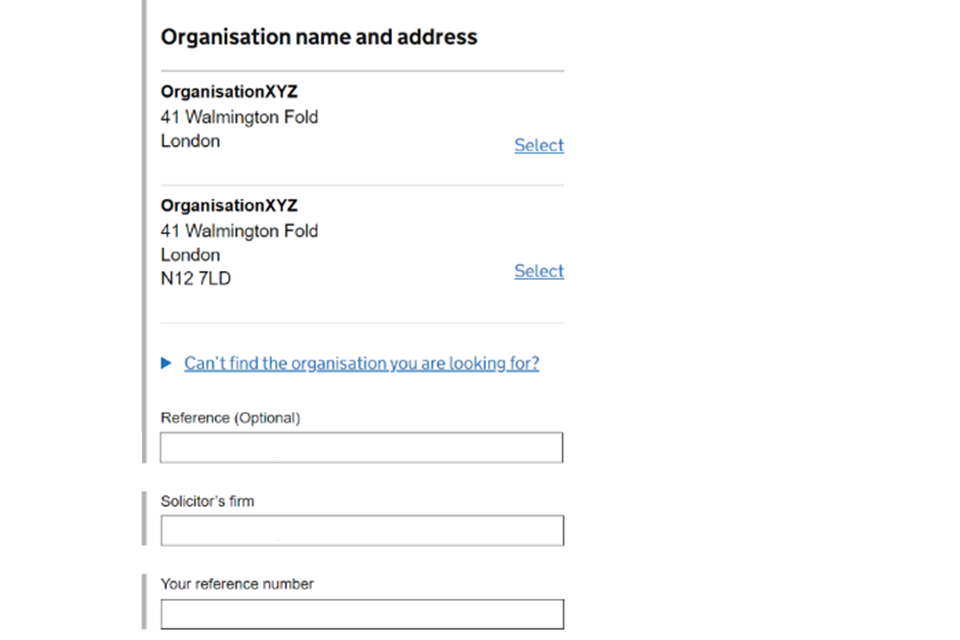
5. Enter your service address and contact details. Then select ‘Continue’.
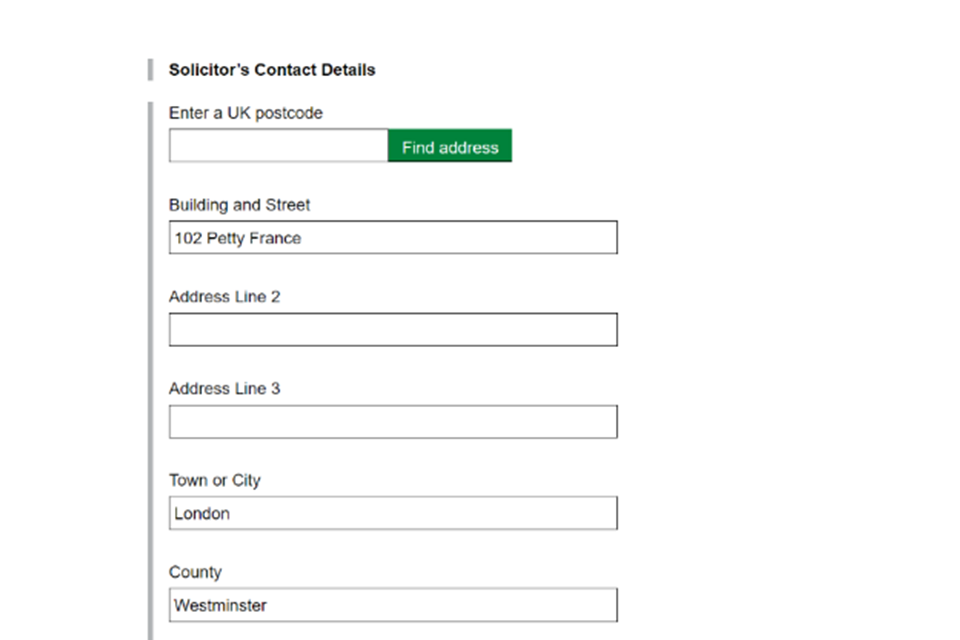
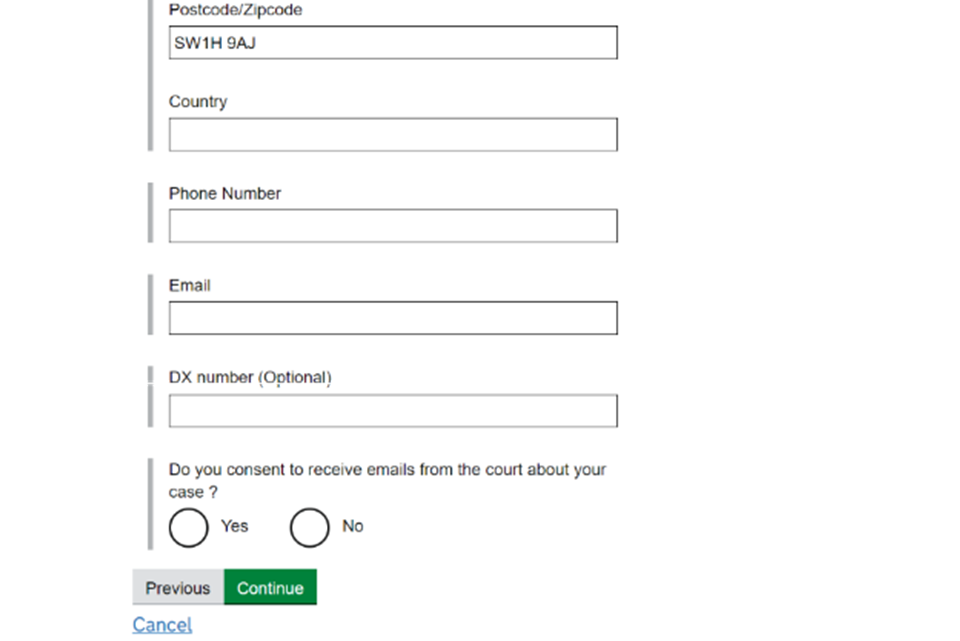
5. Divorce or dissolution details
1. You need to provide the ongoing divorce or dissolution case number.
2. You must upload a copy of the decree nisi, conditional order, final order or decree absolute. This should be in PDF format.
3. If the case relates to civil partnership proceedings, select ‘Yes’.
4. If your case has not reached this stage, you should upload proof of the divorce or dissolution application issue for example, the notice of proceedings from the court.
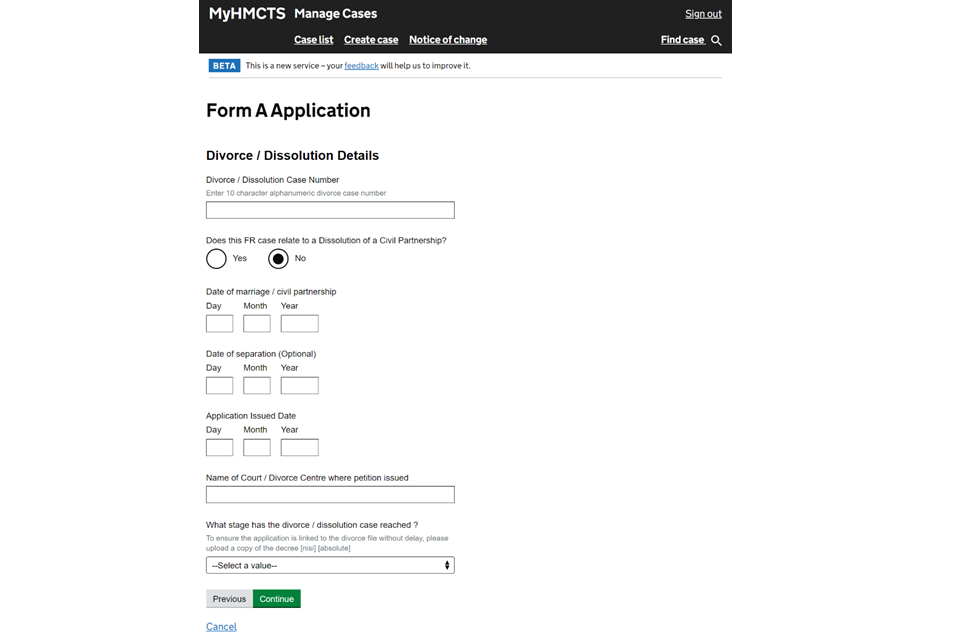
6. Applicant details
1. Your client must be named as the applicant in proceedings.
2. Provide the applicant’s full name, including any middle names, and their address. It must match the information given on the divorce case.
If the applicant’s contact details are confidential, you must select ‘Yes’ to the question ‘Keep the applicant’s contact details private from the respondent?’. These details will then just appear in a ‘Confidential applicant’ tab, which only you and the court can view.
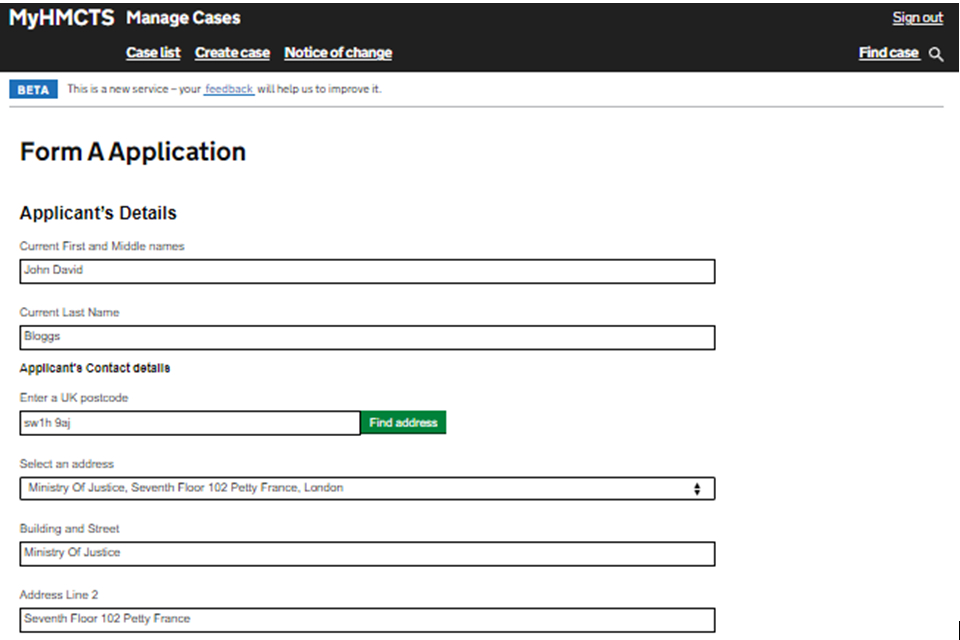
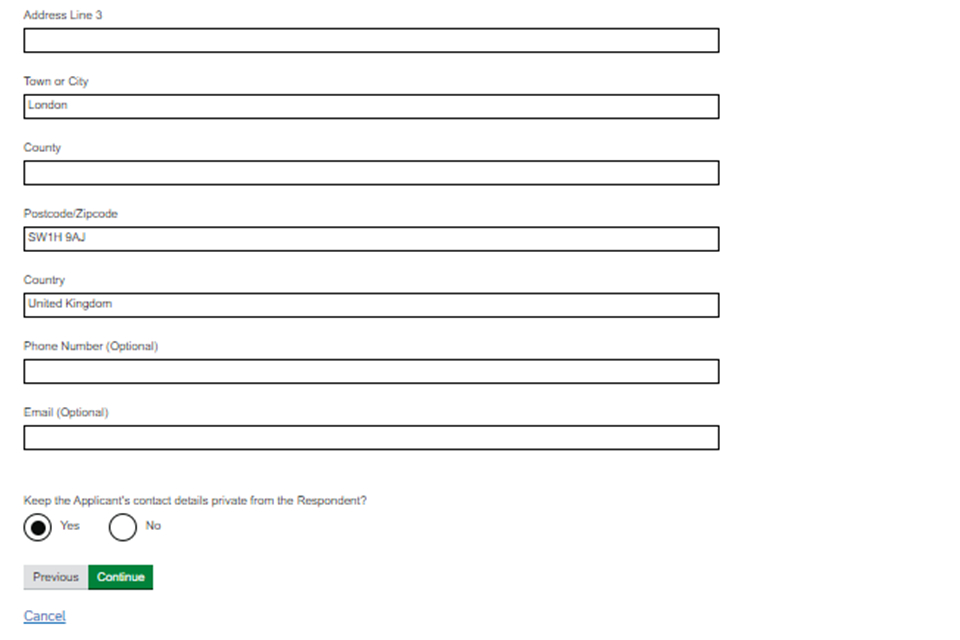
If the applicant lives outside the UK, select ‘Yes’ to the question ‘Does the applicant live outside of the UK?’. Then select ‘I can’t enter a UK postcode’.
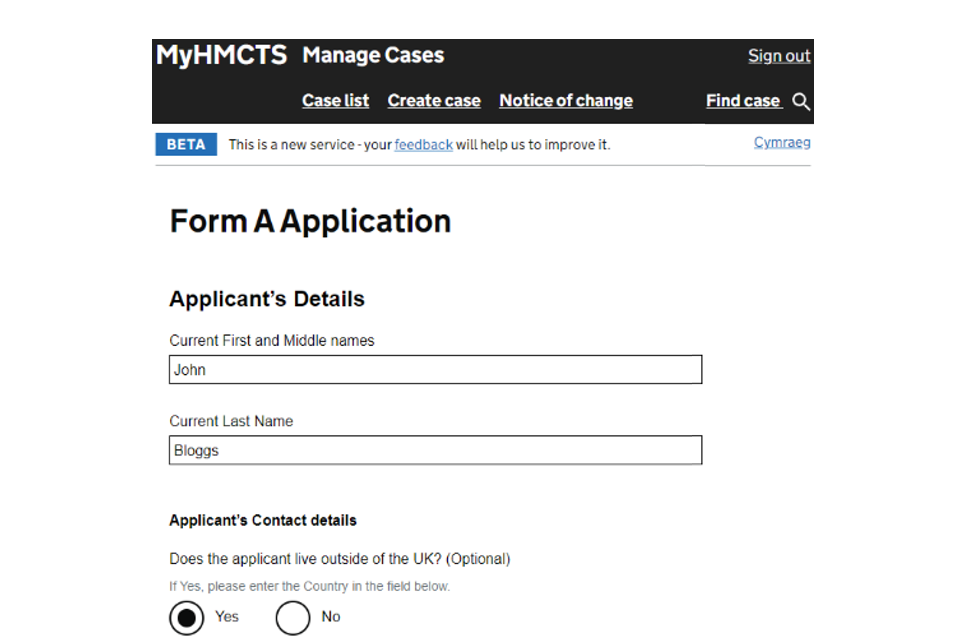
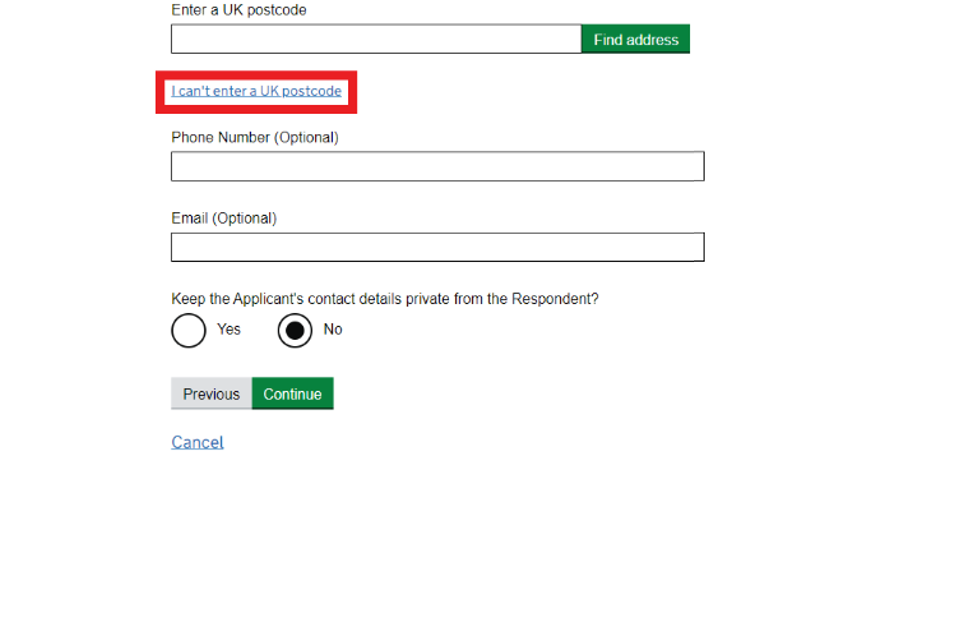
Then enter the applicant’s full overseas address, including their country of residence.
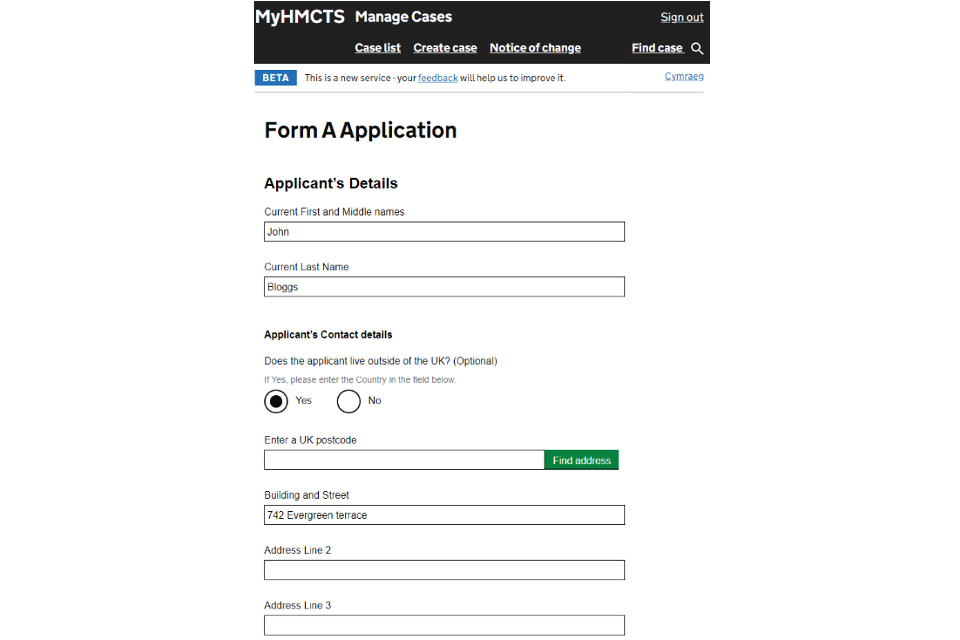
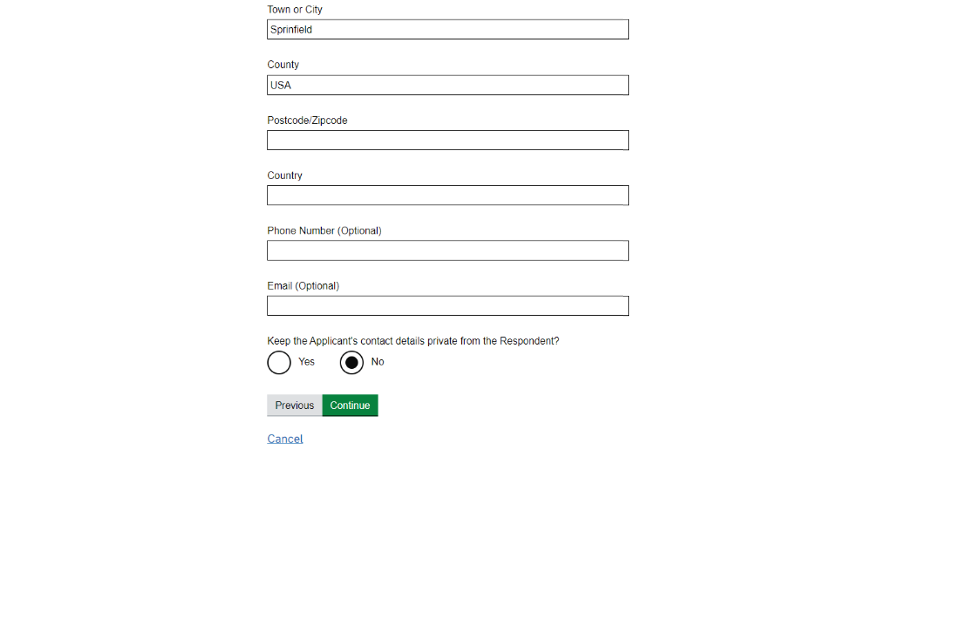
7. Respondent details
1. Enter the respondent’s full name as it appears on the divorce application.
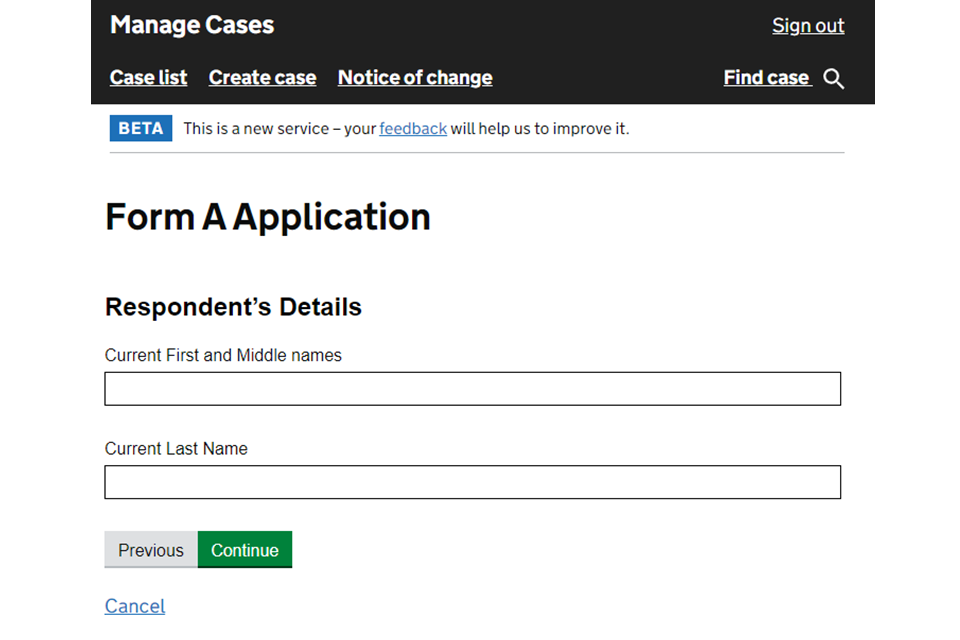
2. Enter the respondent’s contact details. If they do not have a solicitor enter ‘No’ at the prompt and add in their address details.
If you know the respondent’s contact details but they are confidential, you must not disclose them to the applicant. You must select ‘Yes’ to the question ‘Keep the respondent’s contact details private from applicant?’. These details will then just appear in a ‘Confidential respondent’ tab, which only the respondent’s solicitor and the court can view.
If the respondent is in prison, add ‘Rule 39’ before entering the prison address. This makes sure that the correct procedures are followed when sending correspondence to the prison.
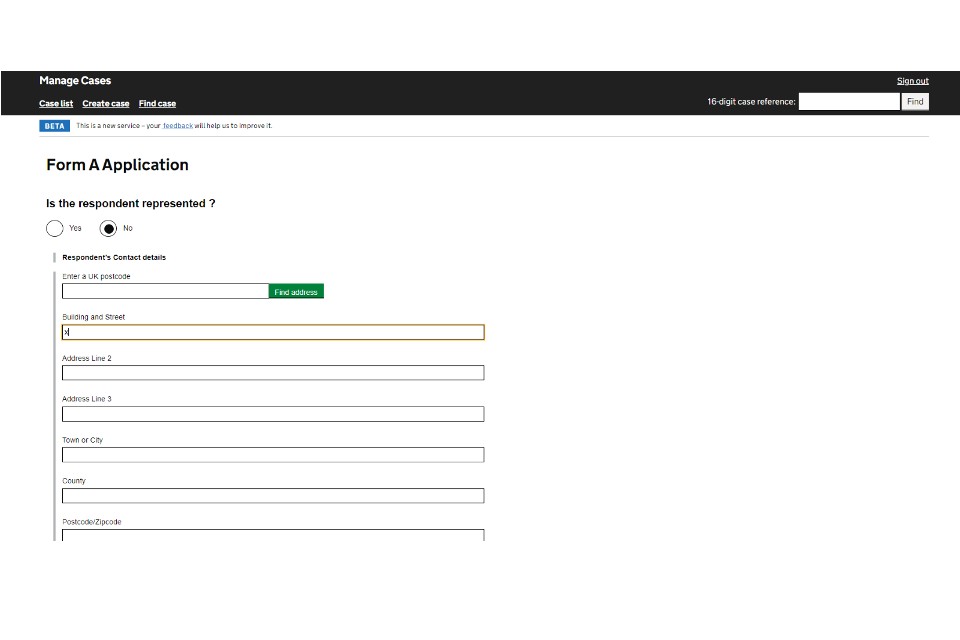
If the respondent lives outside the UK, select ‘Yes’ to the question ‘Does the respondent live outside of the UK?’. Then select ‘I can’t enter a UK postcode’.
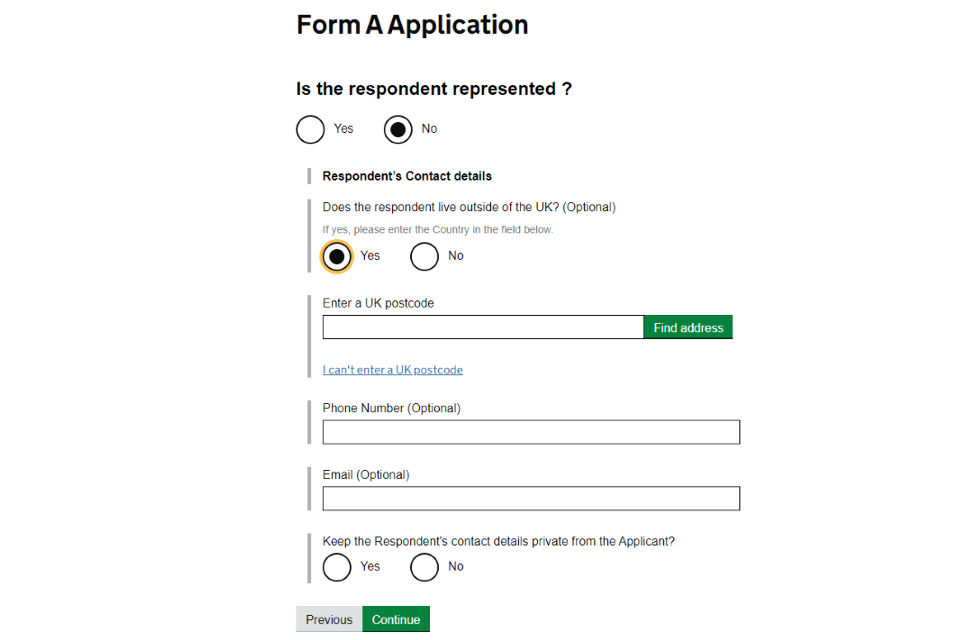
Then enter the respondent’s full overseas address, including their country of residence.
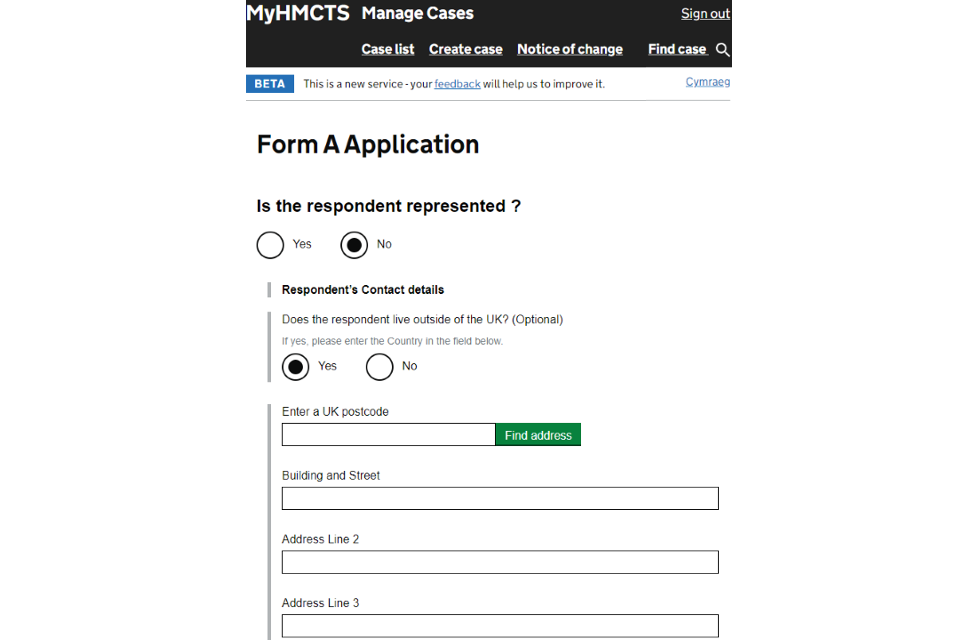
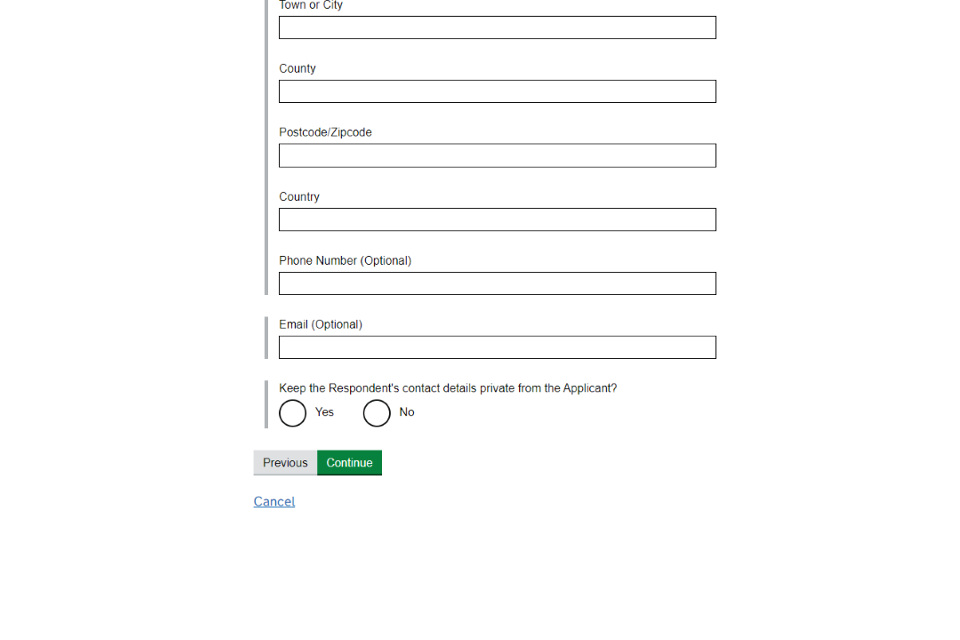
3. If the respondent is represented, you must provide details of their solicitor.
4. Use the ‘Search for an organisation’ to add them to the file. You can search using their postcode or name.
5.Once you have found the correct organisation, choose ‘Select’. If you do not select the respondent’s organisation, the respondent solicitor will not be able to access the case.
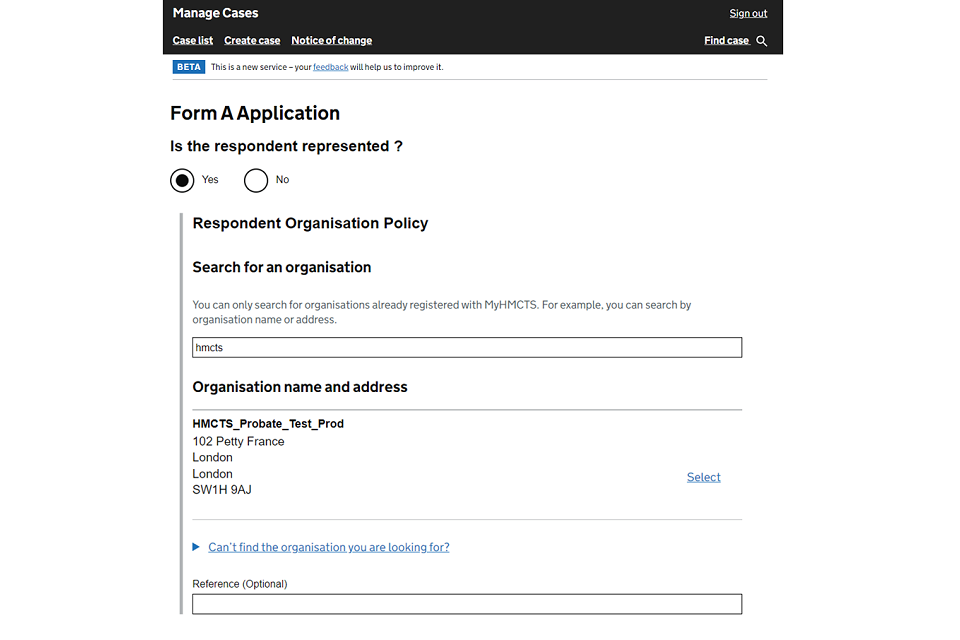
6. If you are unable to find them, they may not have registered with MyHMCTS. You can continue with the application without these details.
7. You need to provide the address for service and contact details for the respondent’s solicitor.
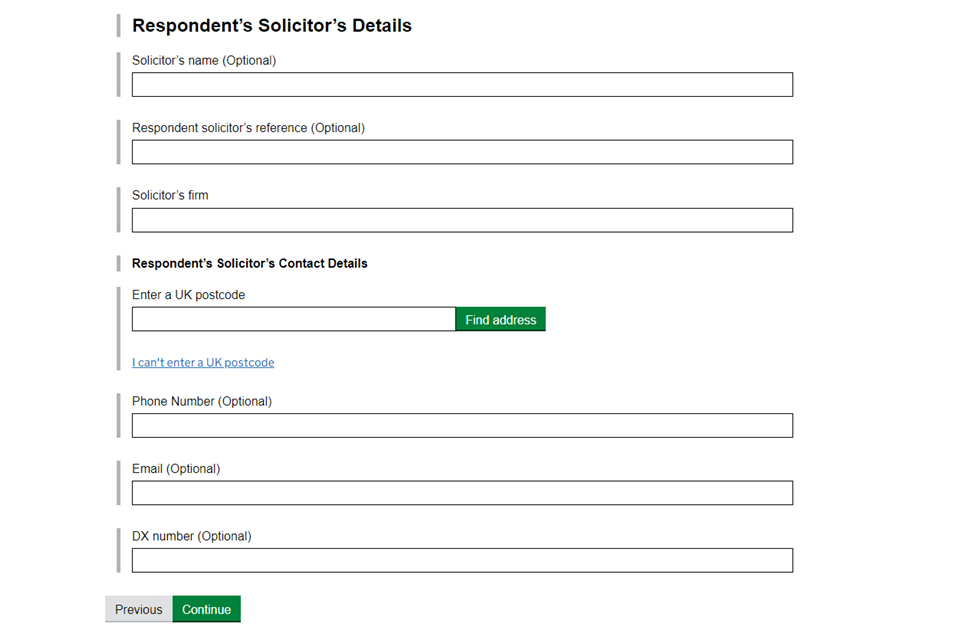
8. Include a reference number for the respondent solicitor where possible.
9. If you cannot find the respondent solicitor’s organisation, they will not have access to the digital files but can still receive the paper files.
8. Nature of application
1. You need to complete some specific questions from Form A.
2. Select at least one of the types of application listed in the section.
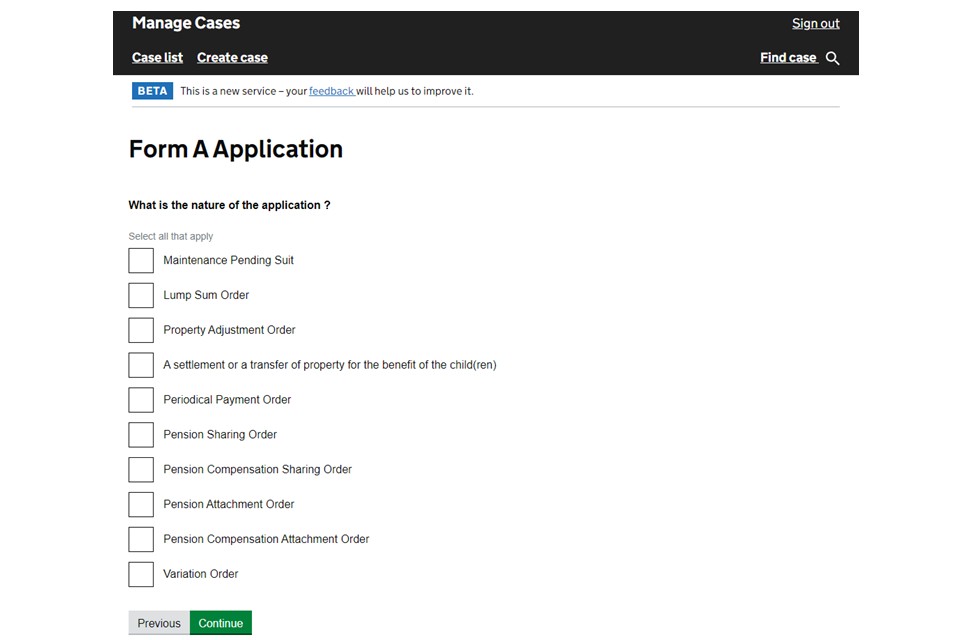
3. If you are applying for maintenance pending suit (MPS) you must also upload a D11 application form. If you do not, your application will not be listed for an MPS.
4. If you have selected ‘Variation Order’ as the nature of application, you can upload a copy of the original order later in the application.
5. If you select ‘Property adjustment order’ for example, you will need to provide details of properties and mortgages.
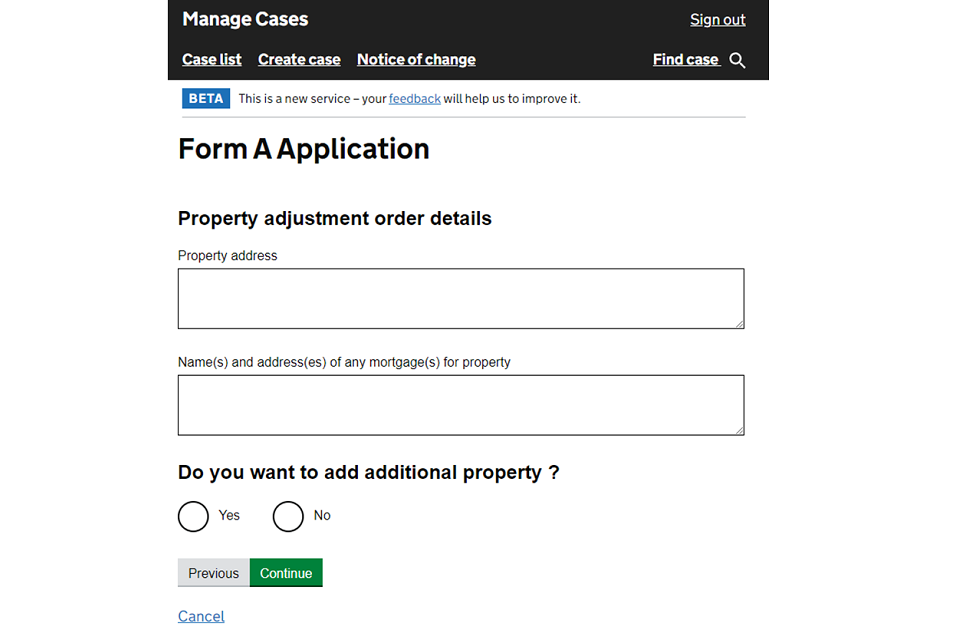
6. If you select the nature of application as ‘Periodical payments’ you must answer some questions about the provision of payments.
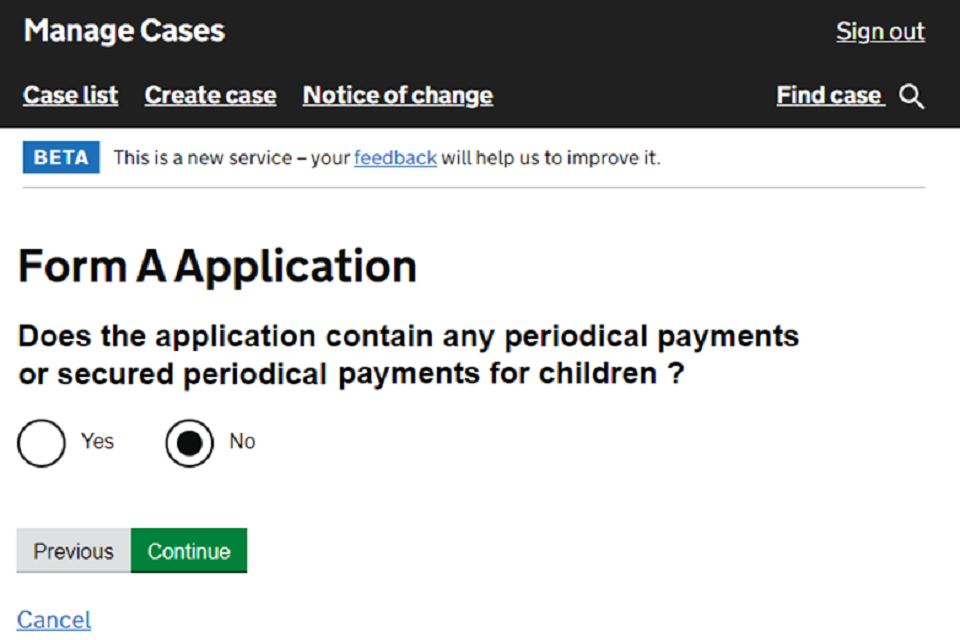
7. If the application contains periodical payment you will be asked for more details. If it does not, you are fast tracked to the next question.
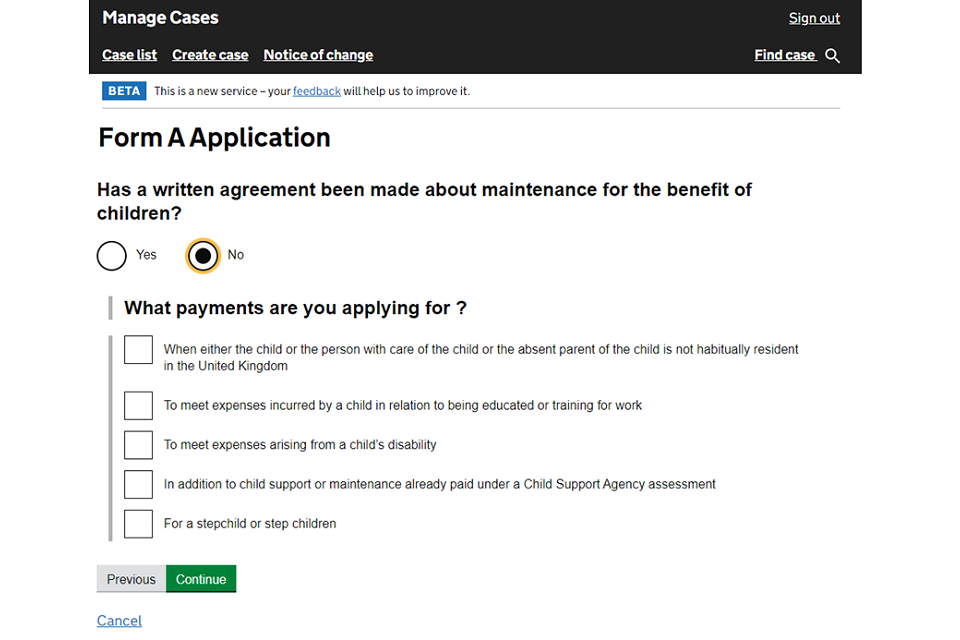
9. Fast track
1. If your case can be managed under the fast track procedure, select ‘Yes’ and choose a reason.
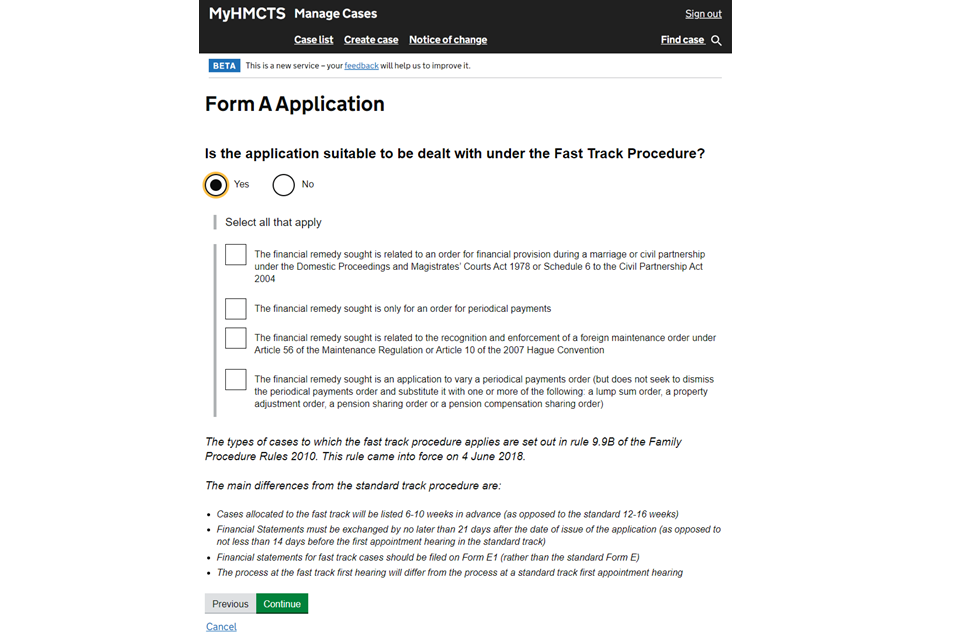
10. Complexity
1. Answer the complexity questionnaire.
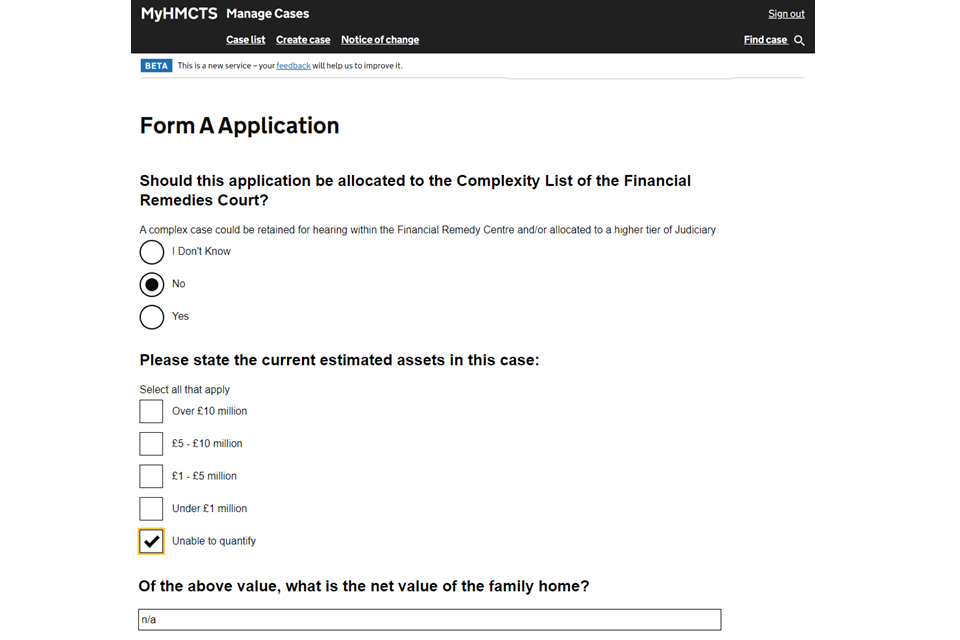

11. Which financial remedy court
1. You must make your application to the financial remedy court (FRC) closest to the applicant – do not select the FRC closest to the solicitor. Find a court or tribunal. If you do not select the applicant’s local FRC you must explain why in the space provided.
You cannot select the High Court or Royal Courts of Justice. The application must be issued at a local FRC and transferred to the High Court or Royal Courts of Justice.
If you need your case to be transferred to the High Court, select ‘Yes’ to the question ‘Do you consider that the case should be allocated to be heard at High Court Judge level?’ You must use the text box to explain why you need your case to be transferred.
2. Add your reason for selecting this FRC. Then select ‘Continue’.
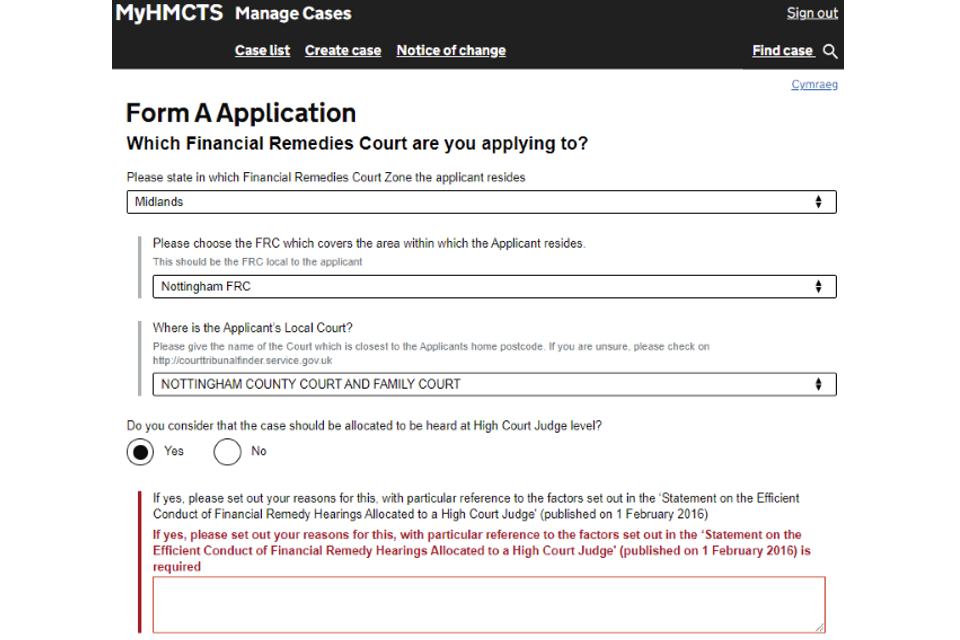
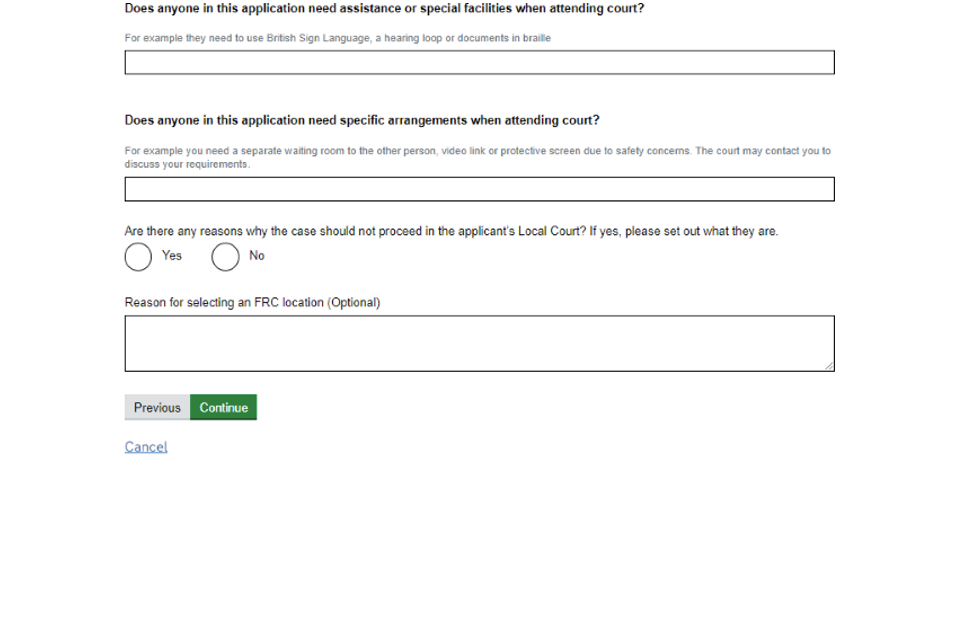
Your case may be automatically entered into the express financial remedy pilot if:
- you select a court that is taking part in the pilot
- the parties’ combined net assets are below £250,000
If your case is eligible for the pilot, you will be taken to a page explaining this. There will be a link to guidance explaining more about the pilot and the timelines for pilot cases.
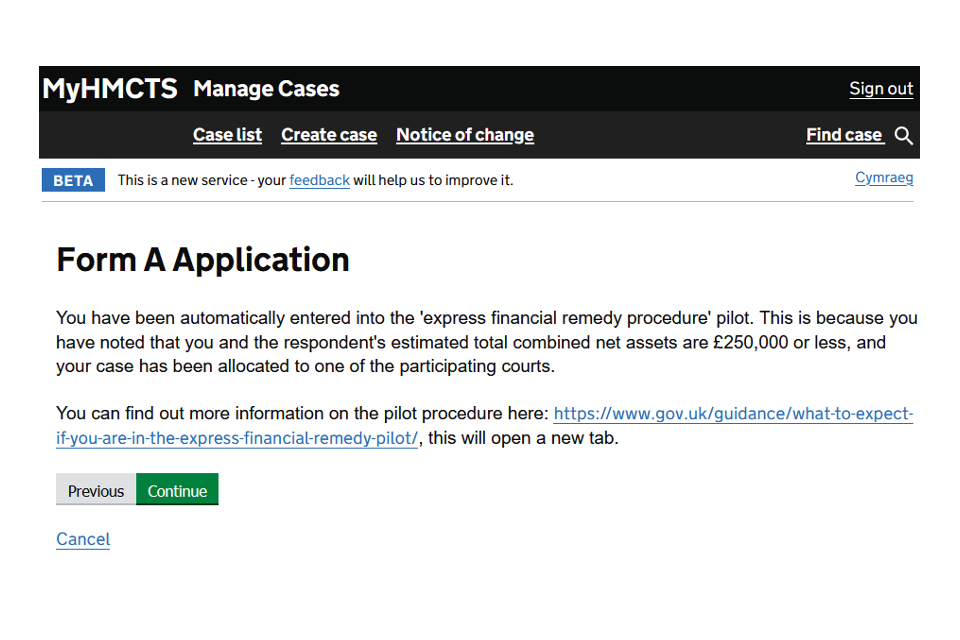
12. Mediation information and assessment meeting (MIAM)
Before making an application for a financial order, the parties must first attend a mediation information and assessment meeting (MIAM). At the MIAM a mediator will consider whether mediation, or another form of non-court dispute resolution (NCDR), would be a more appropriate way to resolve the dispute. The mediator will also signpost parties to other help and support services.
The parties must have attended a MIAM unless you are applying for a consent order or have an exemption from the requirement to attend a MIAM. For example, a party may have an exemption if there has been domestic abuse. See step 6 in this section for more information about exemptions. Where evidence is required to support a MIAM exemption claim, you must submit this evidence alongside your application.
The court will review the evidence to make sure the exemption claim is valid.
1. Select if the applicant has attended a MIAM, then select ‘Continue’.
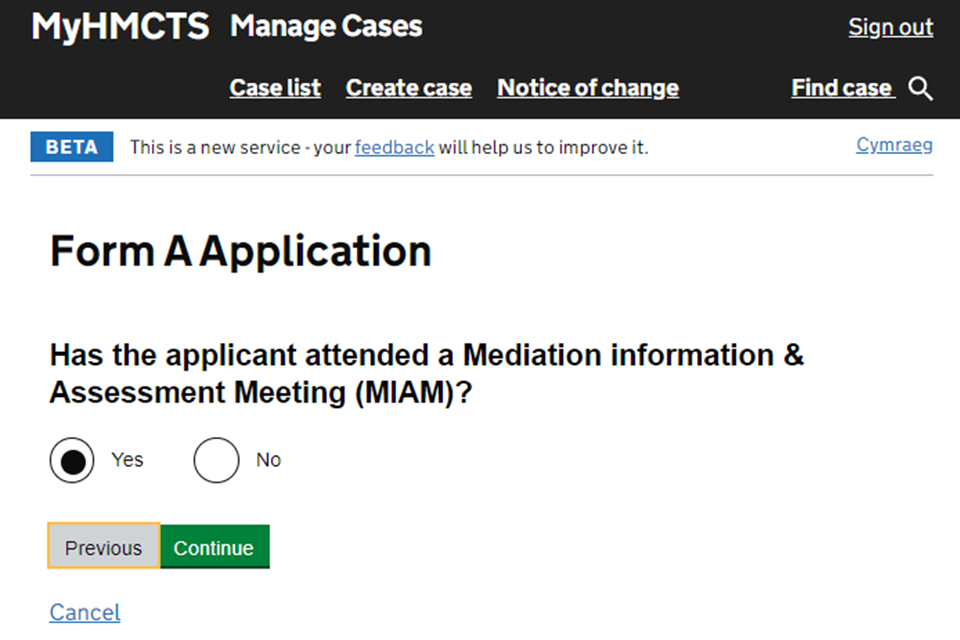
2. If you have selected ‘Yes’, enter the details of the MIAM certification and upload a copy. Then select ‘Continue’. You will now move to uploading other documents.
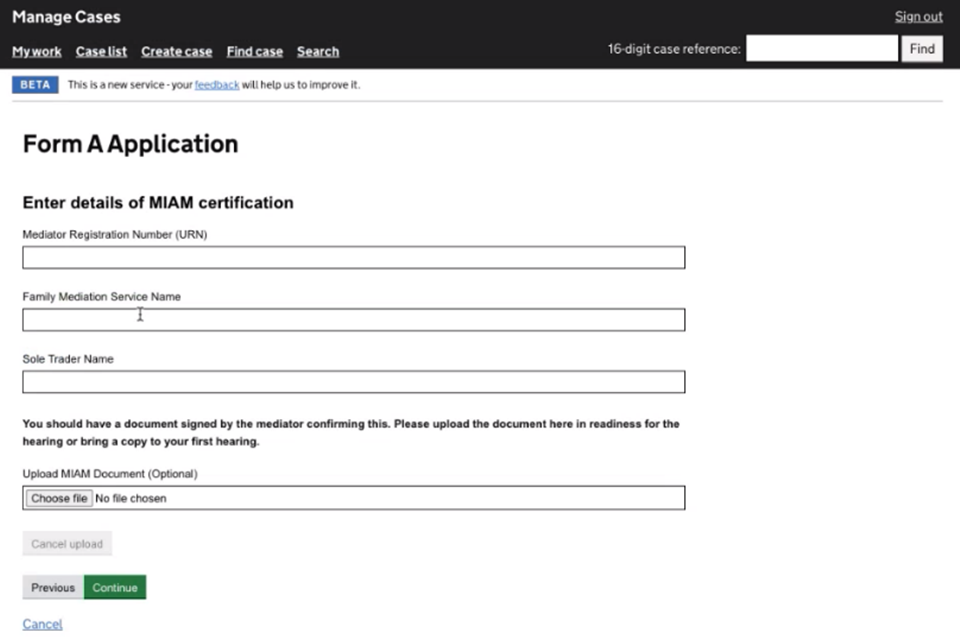
3. If you have selected ‘No’, you will be asked if the applicant is claiming a MIAM exemption.
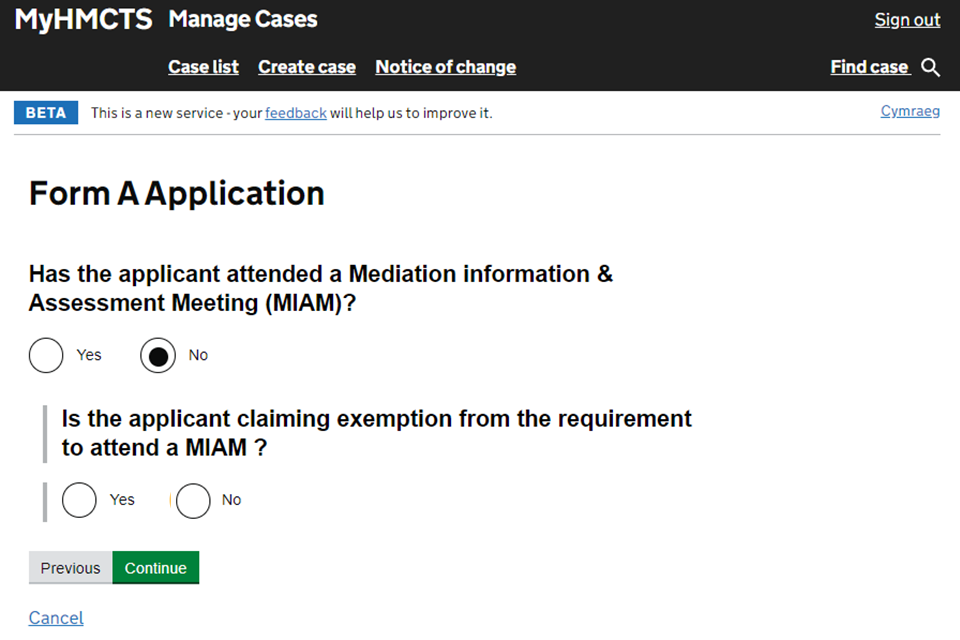
4. If you select ‘No’ to this, you will see an error message and will not be able to continue, as either a MIAM or an exemption is required.
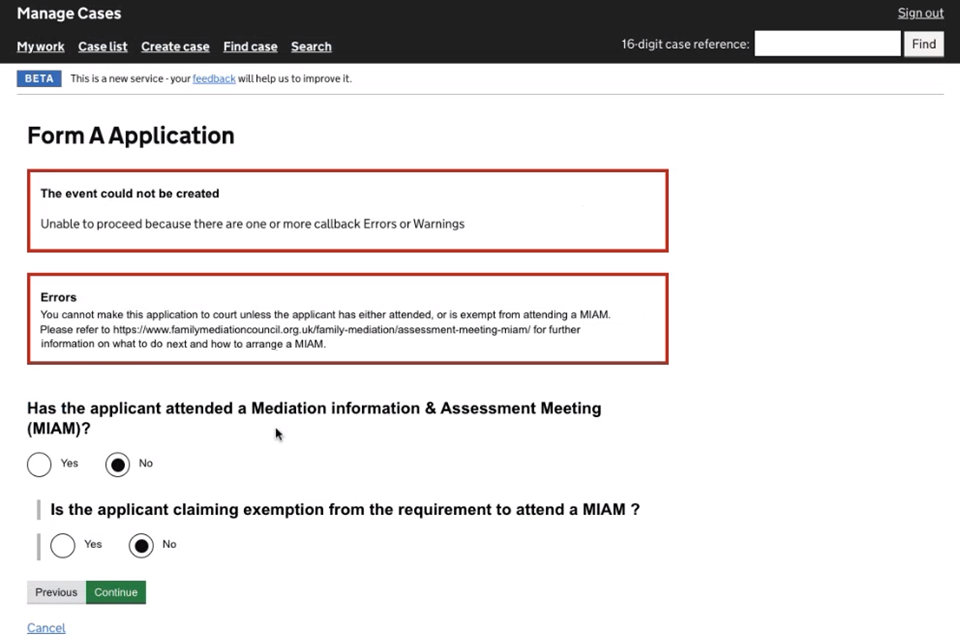
Find out more about MIAMs and how to arrange a meeting on the Family Mediation Council website.
5. If you have selected ‘Yes’ to the exemption, you will be asked the reason why the applicant has not attended a MIAM. Select one of the options and then ‘Continue’.
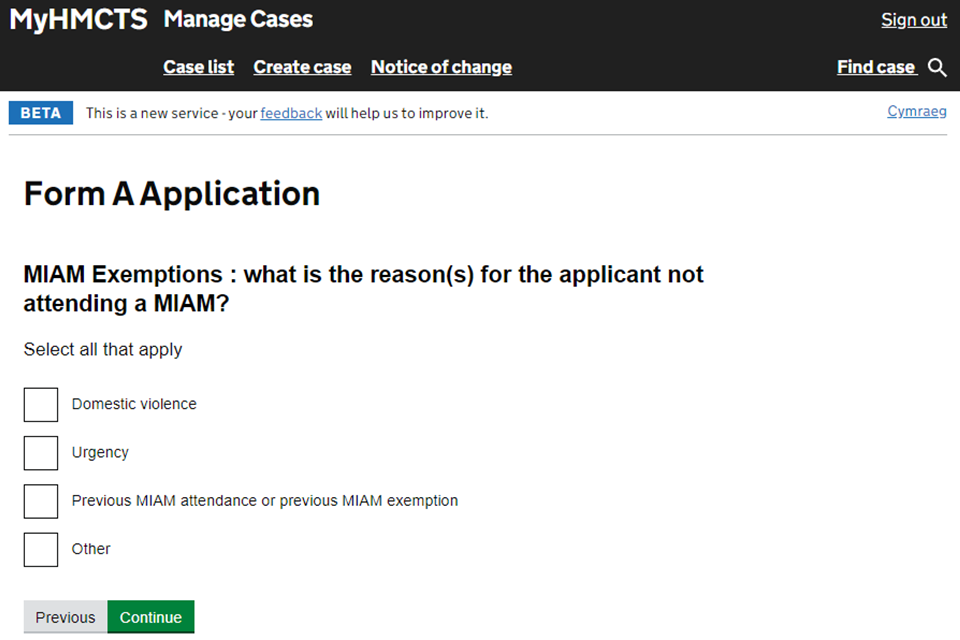
6. If you have selected ‘domestic abuse’ as the reason, you will then be asked what evidence of abuse the applicant has. Select all that apply, then ‘Continue’.
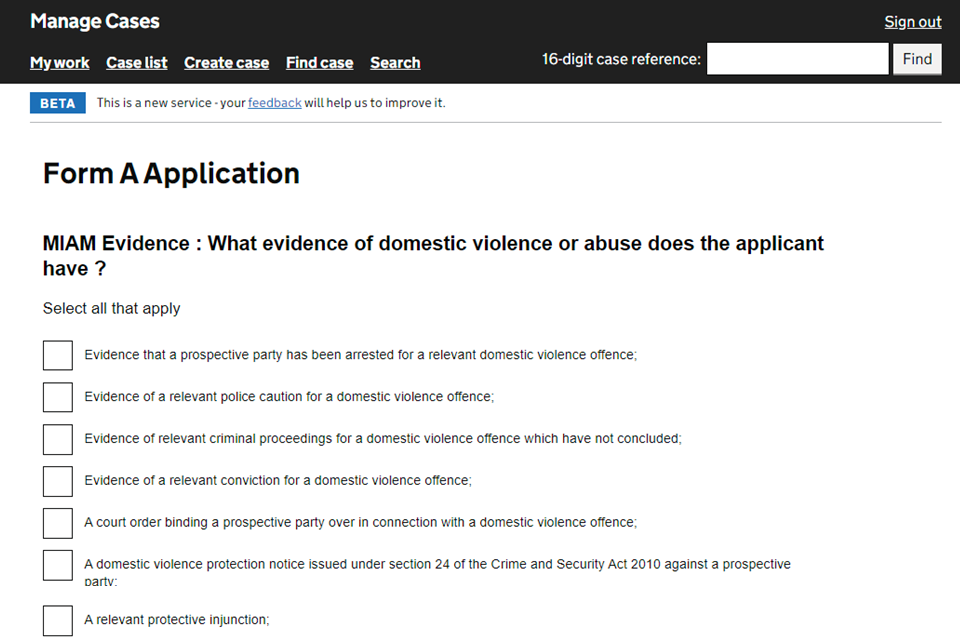
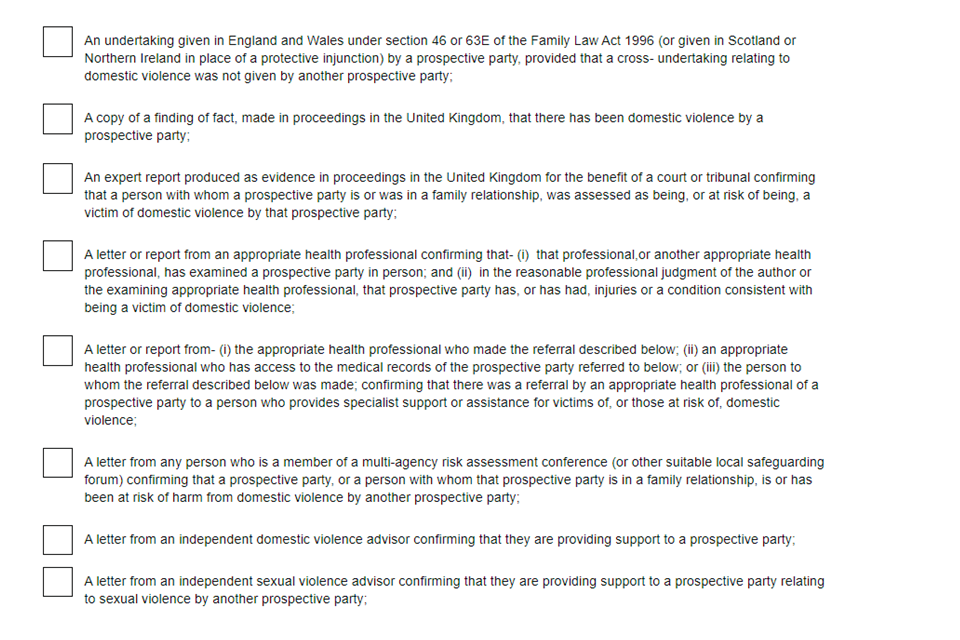
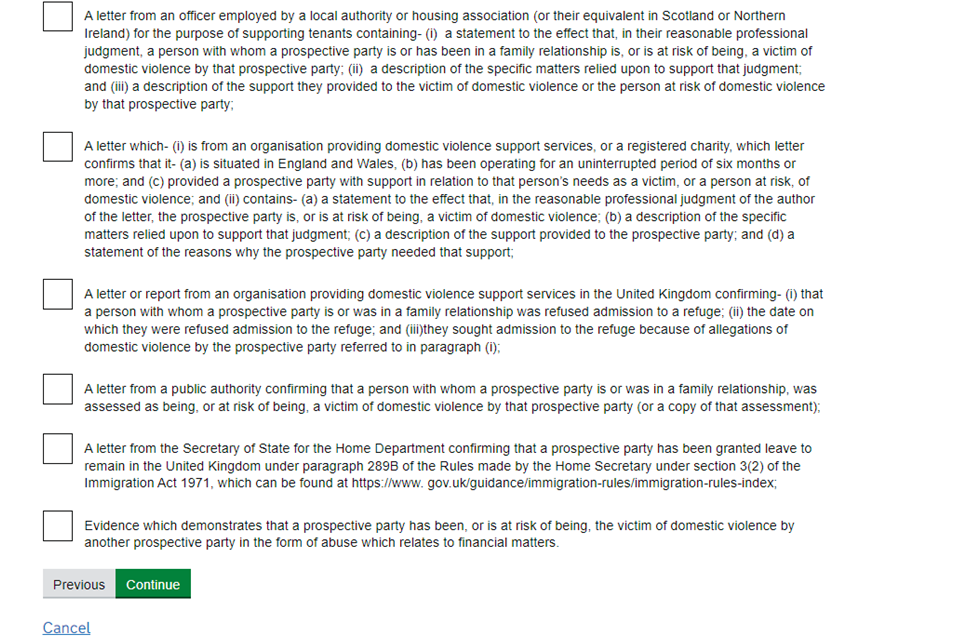
7. If you have selected ‘urgency’ as the reason for the applicant not attending the MIAM, you’ll be asked why the application is urgent. Select all that apply, then ‘Continue’.
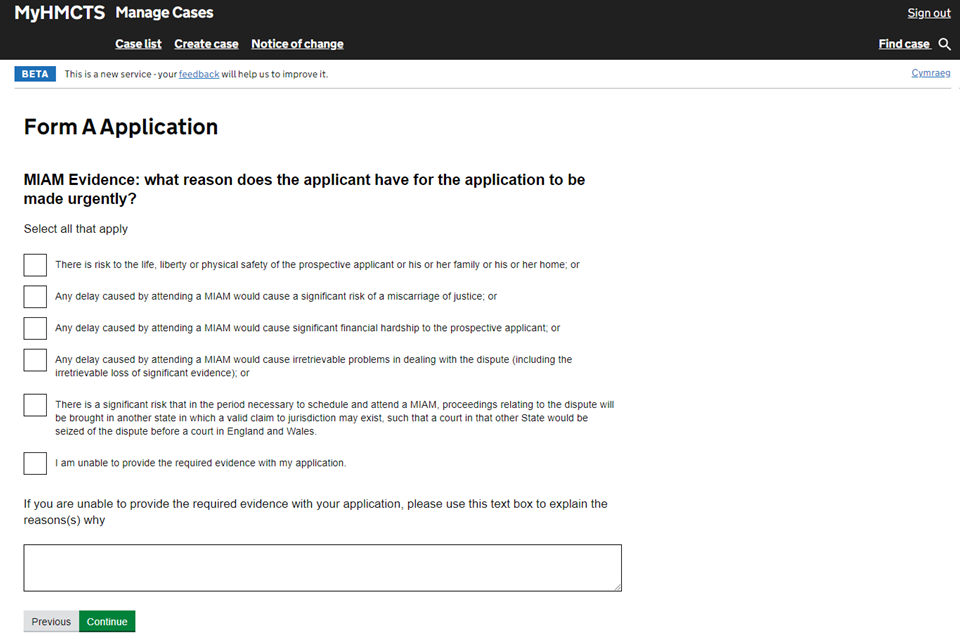
8. If you have selected ‘previous MIAM attendance or MIAM exemption’ as the reason, you’ll be asked what evidence the applicant has. Select one option, then ‘Continue’.
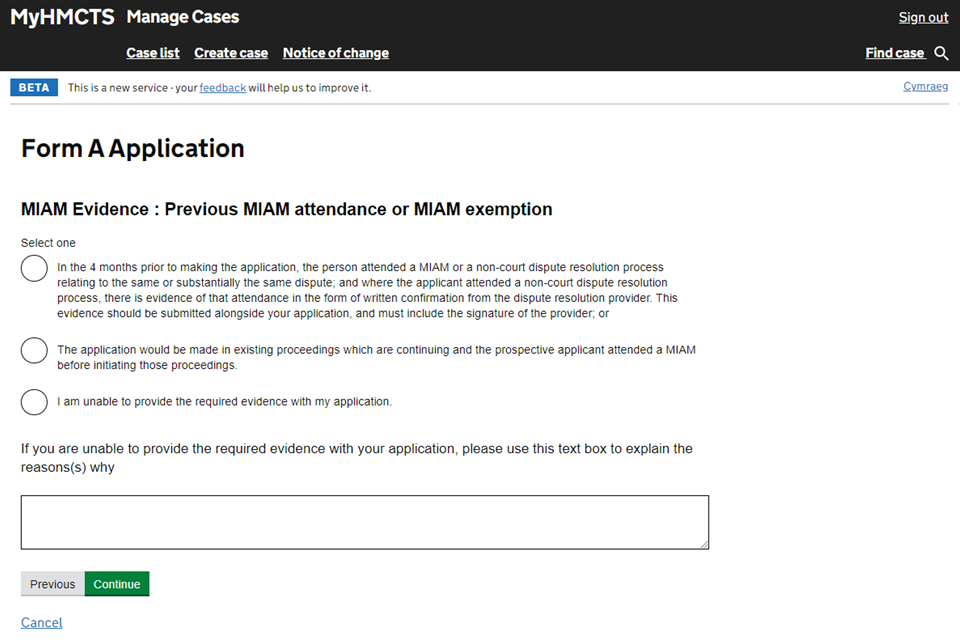
9. If you selected the ‘other’ option for why the applicant has not attended a MIAM, you’ll be asked what other grounds apply. Select one option or, if none apply, use the free text box to add the reason. Then select ‘Continue’.
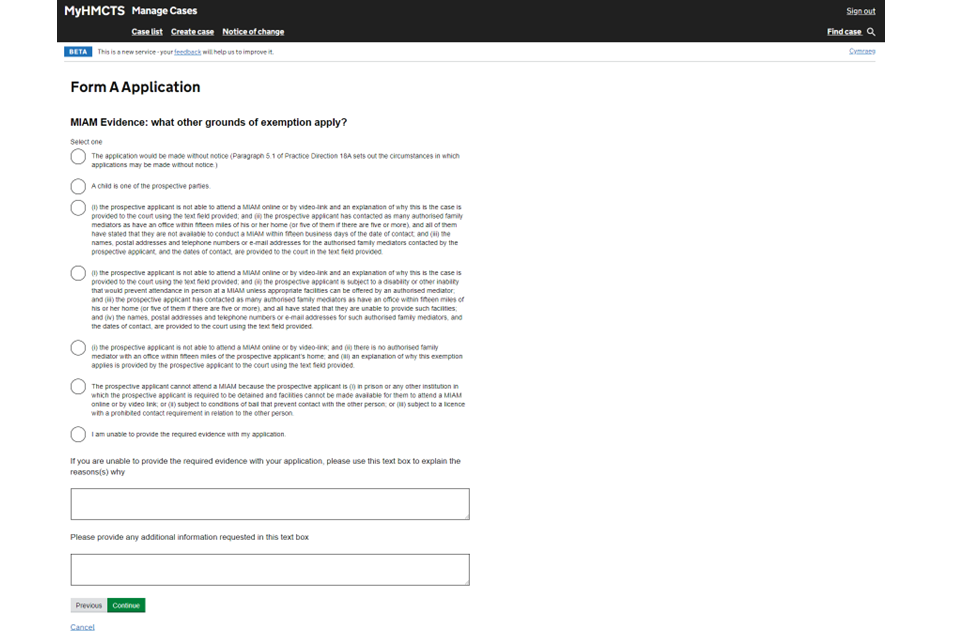
13. Uploading other documents
You can upload additional documents to the case file, such as a statement from the respondent.
It is helpful to the judge if the file name reflects what it is, such as ‘respondent statement on legal advice’.
You must not upload confidential documents before the application has been submitted. Uploaded documents form part of the application and are visible to all parties.
You can upload confidential documents once the application has been drafted. To upload confidential documents, you must use the upload case files function and select ‘Confidential’.
1. If you are uploading a D11 application and a statement in support of an MPS application, make sure this is in PDF format and is labelled as an MPS statement using the dropdown list.
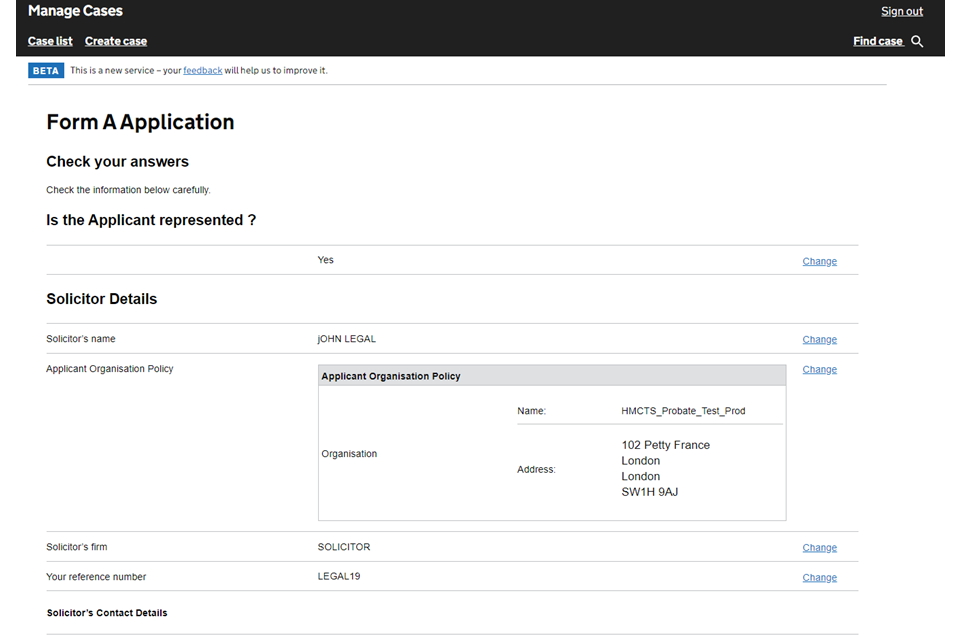
2. If the case is urgent, select ‘Yes’ and provide the details – for example, delays would create financial hardship for the applicant.
You must only select ‘Yes’ where there is a valid and reasonable need for urgency. Do not select this otherwise.
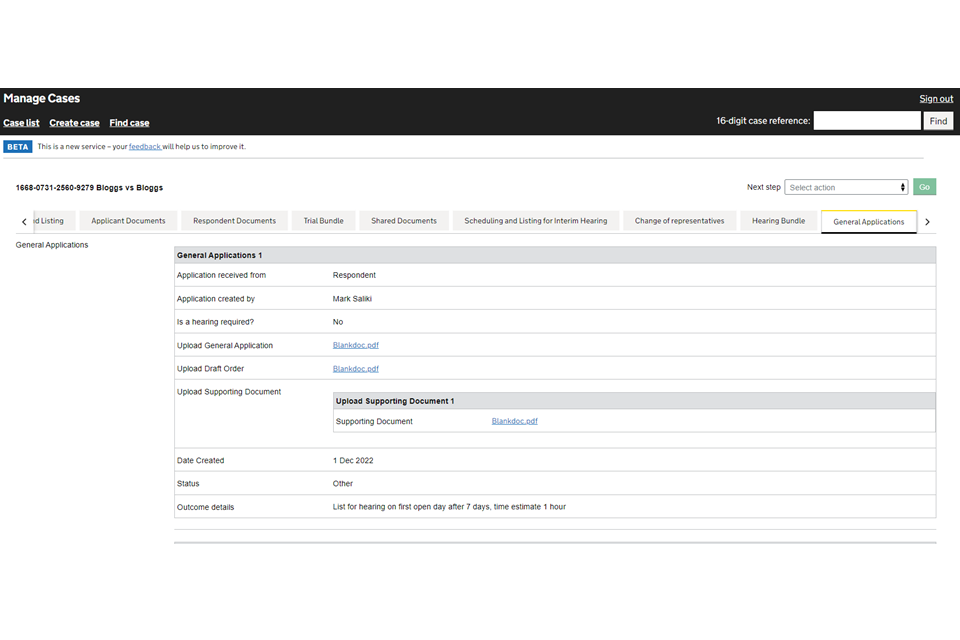
14. Check your answers
1. Check your answers before you save the draft application.
2. If you need to amend anything, select ‘change’ and you will be taken back to the relevant section.
3. You can also amend your application before it is submitted.
4. If you do not need to change anything, select ‘submit’ at the bottom of the page.
5. This will save the draft application.
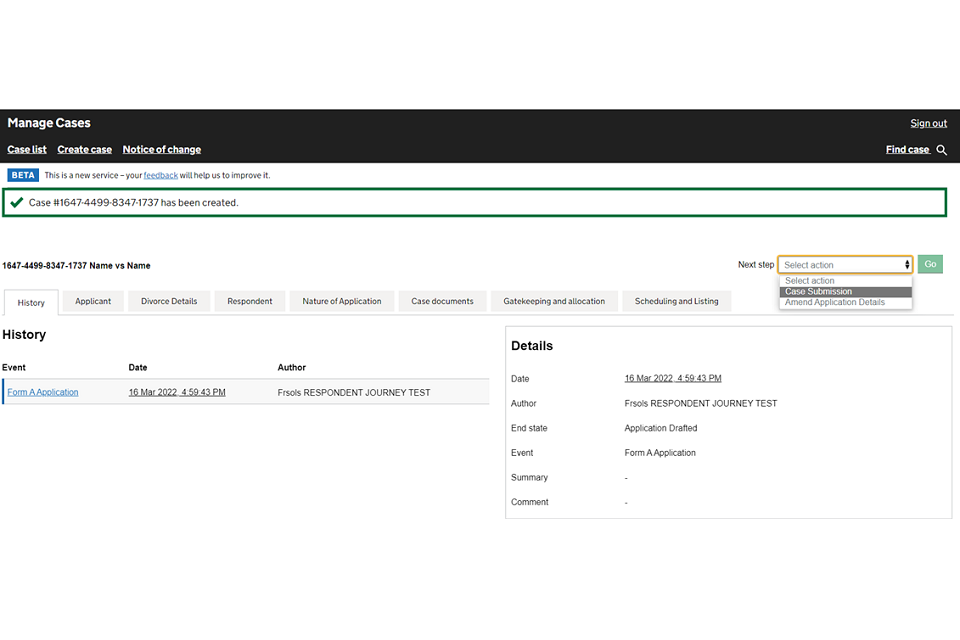
15. Submit the application
Before submitting the application, you can review the documents and information provided.
1. If you want to amend the application, select ‘Amend application details’.
2. If you want to submit, select ‘Case submission’.
If you’re a solicitor who is not based in the UK and you do not have a PBA account, do not select ‘Case submission’. Instead, you must contact hmctsfinancialremedy@justice.gov.uk to arrange payment.
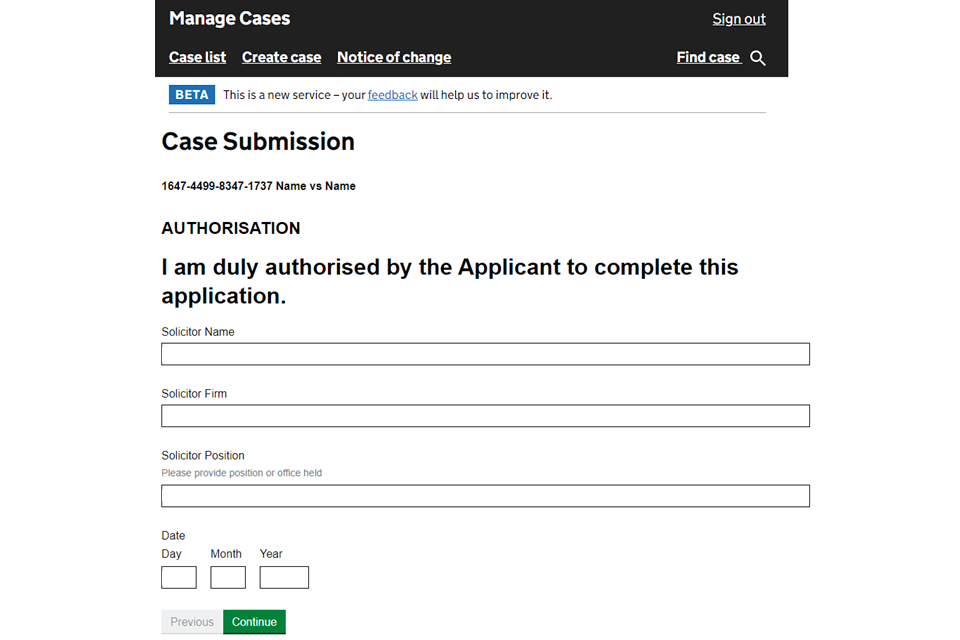
Sign the statement of truth
1. Complete the prompts to digitally sign the statement of truth.
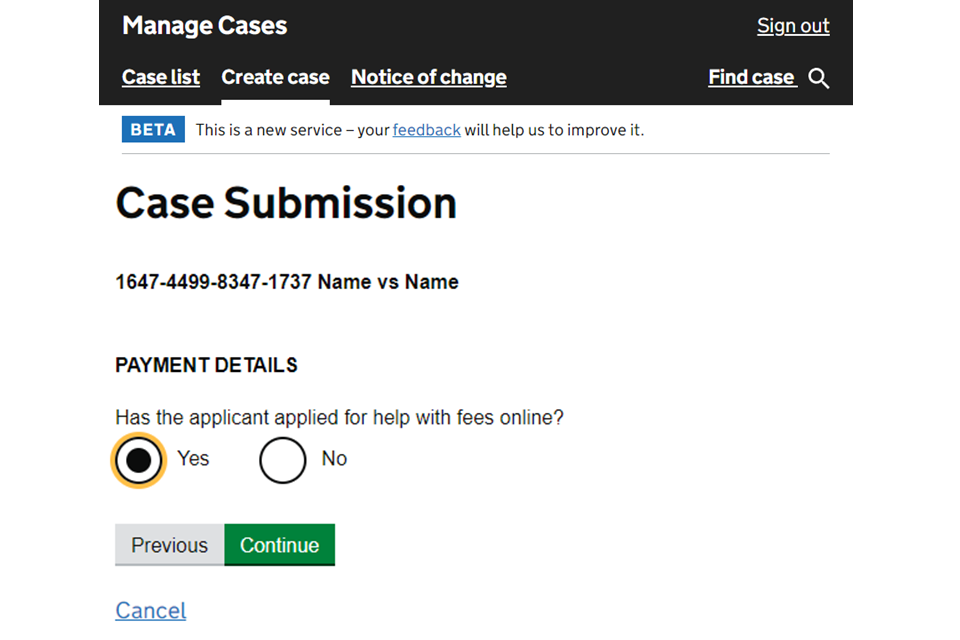
Select payment method – help with fees
1. If you have applied for help with fees online, select ‘Yes’ to the prompt.
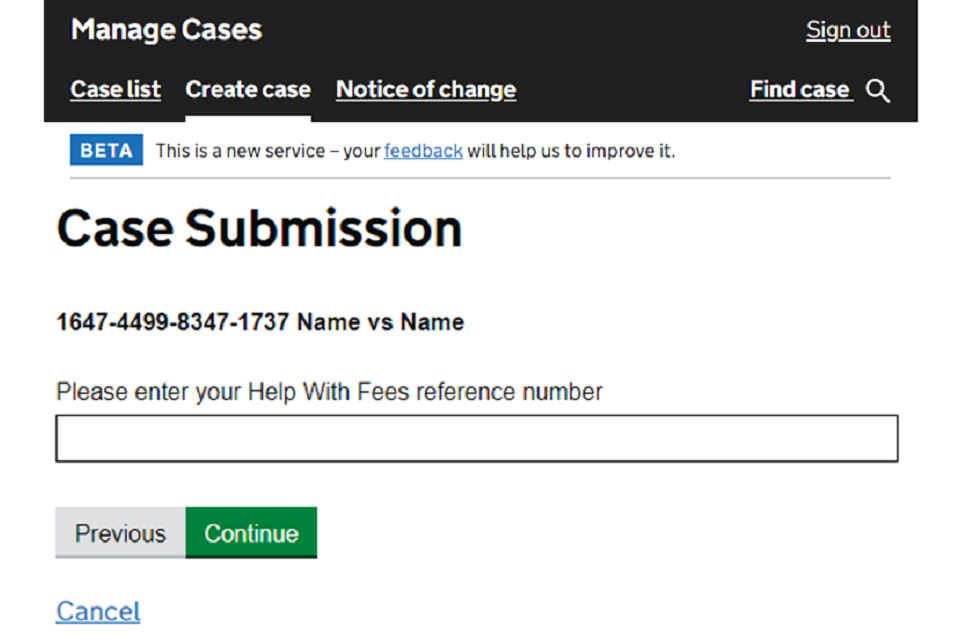
2. Enter the help with fees reference which should be unique to this application. You must not reuse a help with fees reference.
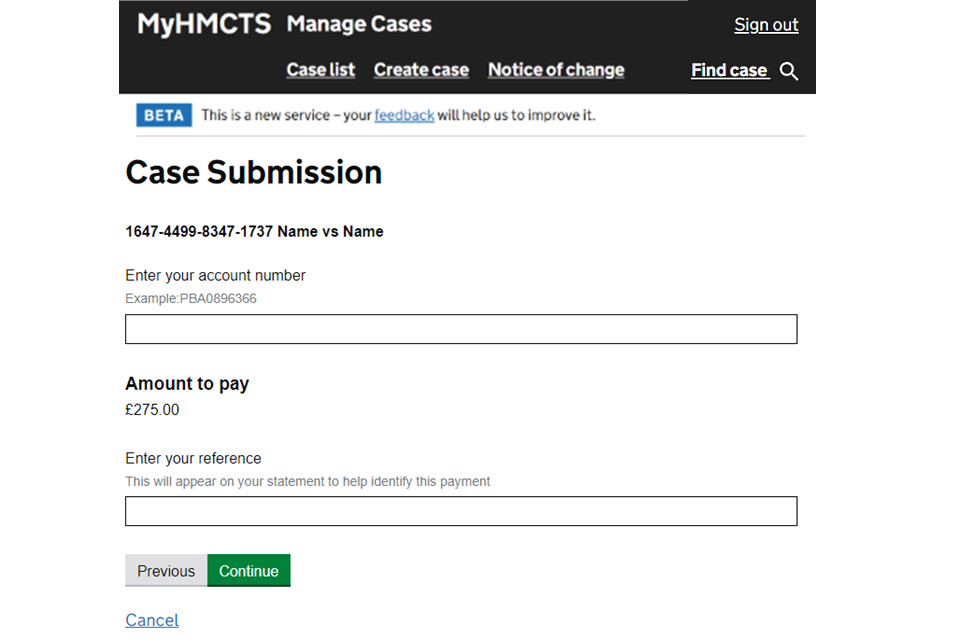
3. If you have not applied for help with fees then select ‘No’.
4. Enter your organisation’s PBA account number and your reference number.
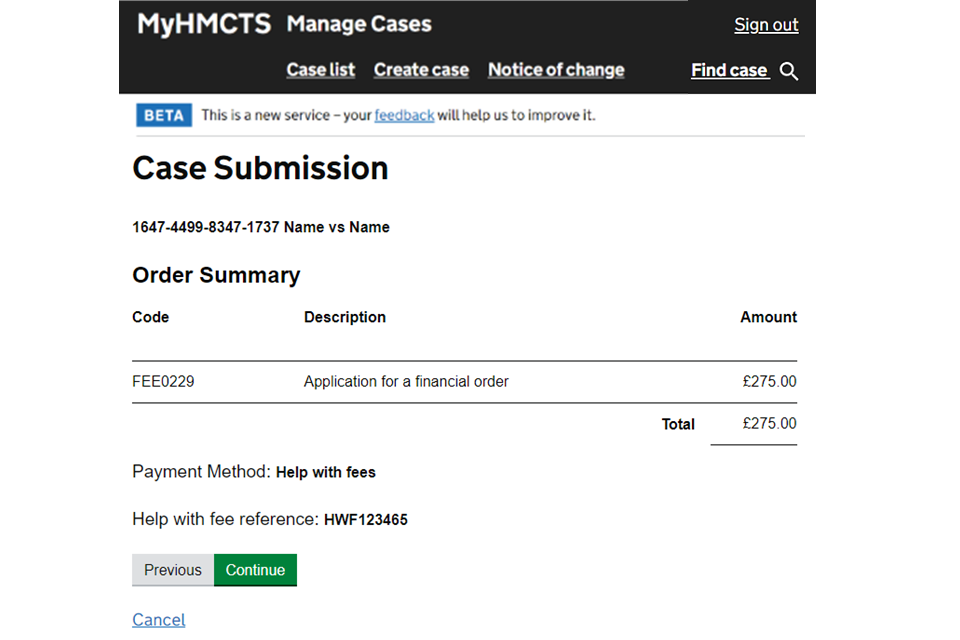
Final check and submit
1. If you have no amendments, select ‘Continue’ on all the information pages until you get to the submit button.
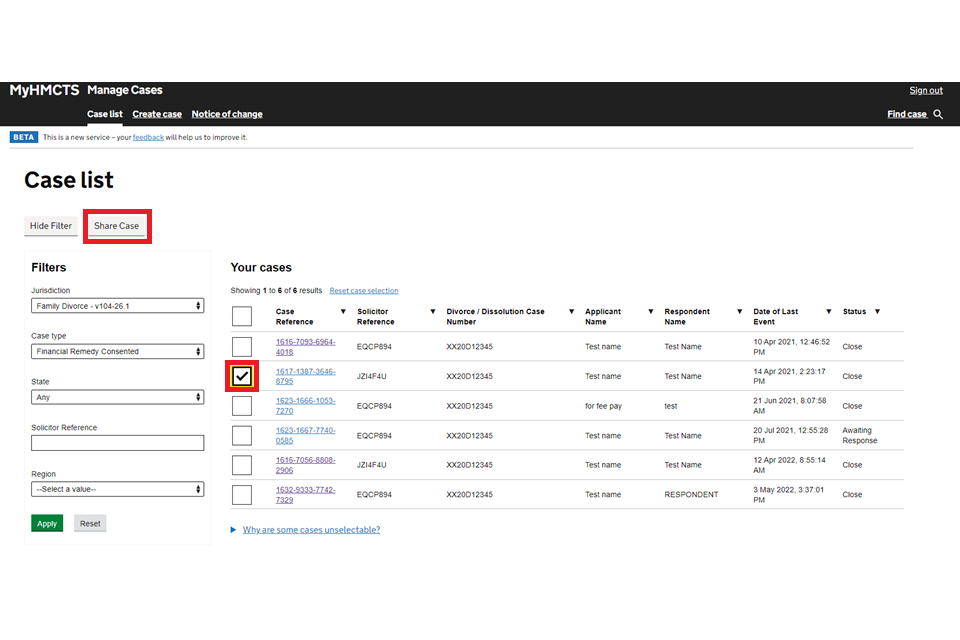
Once you have submitted, your application is sent to the FRC to be checked and issued.
The court sends you an email once the case is issued.
You can monitor your case by checking the history tab.
16. Lock and key case
Lock and key protocols apply to cases that need restricted access, such as cases involving high-profile parties.
The applicant must contact the financial remedy court allocated to their case and request that the lock and key is applied. This must be done when the application is issued.
The court will add a flag to the case. This will say the case is a lock and key case, and only those authorised by the court should access and manage it.
17. Make a schedule 1 application
The fee for a schedule 1 application is £232.
If you need to make a consented schedule 1 application, use the contested schedule 1 application. Once the case has been issued, use the ‘consent order’ option to make the application consented. The same fee applies.
1. Follow the instructions for creating a case.
2. Enter the solicitor details. Select ‘Under paragraph 1 or 2 of schedule 1 children act 1989’ as the application type. Then select ‘Continue’.
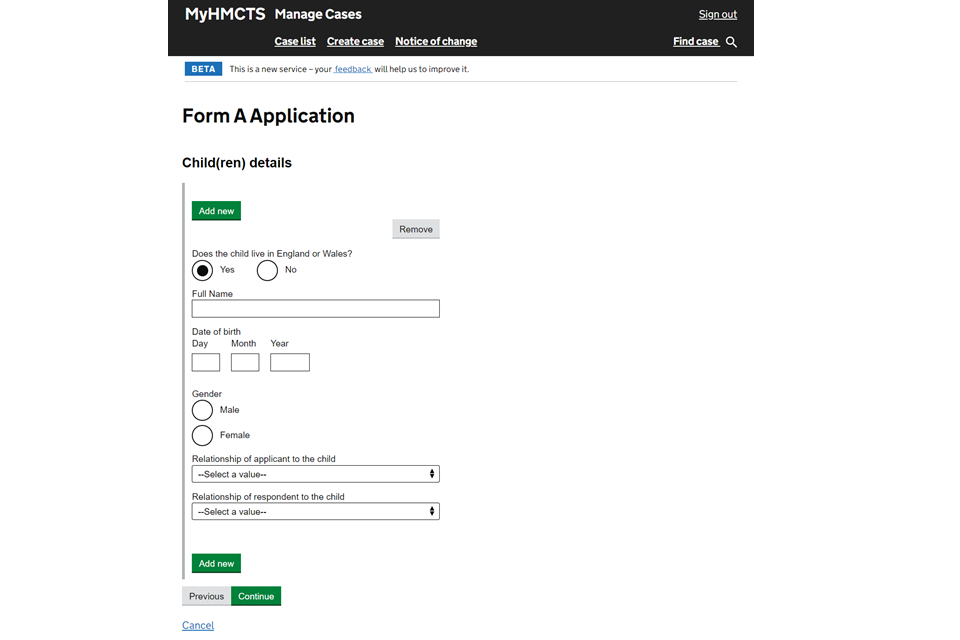
3. Add the applicant’s details.
4. On the child’s details page, select ‘Add new’ then add the child’s information. When you’ve added all the information, select ‘Continue’.
You must choose ‘Yes’ to say the child lives in England or Wales’.
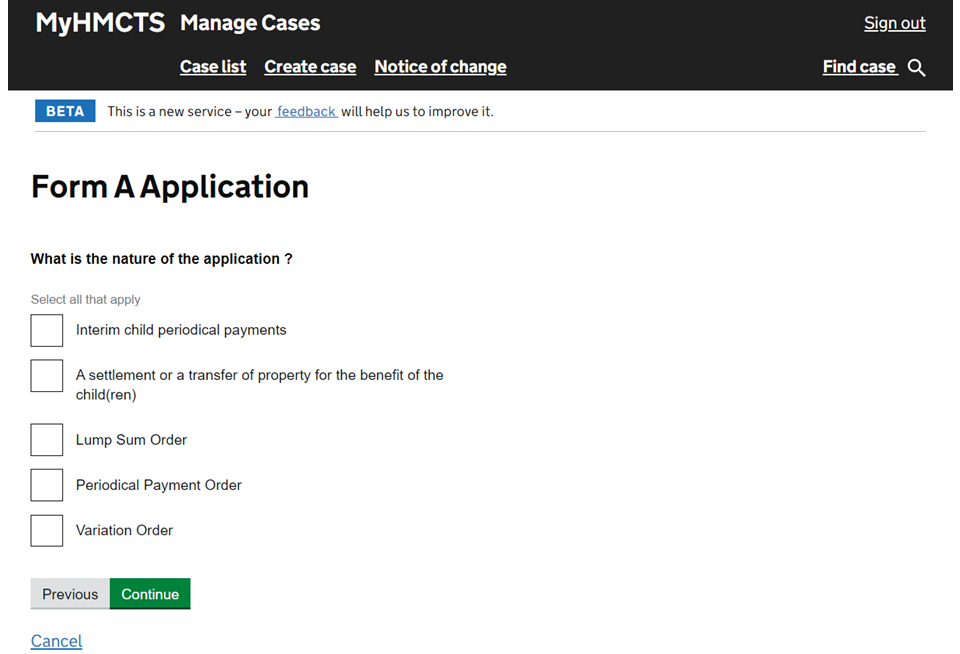
5. Add the respondent’s details, including their solicitor’s details, if they have one.
6. Select the nature of the application – check all that apply. Then select ‘Continue’.
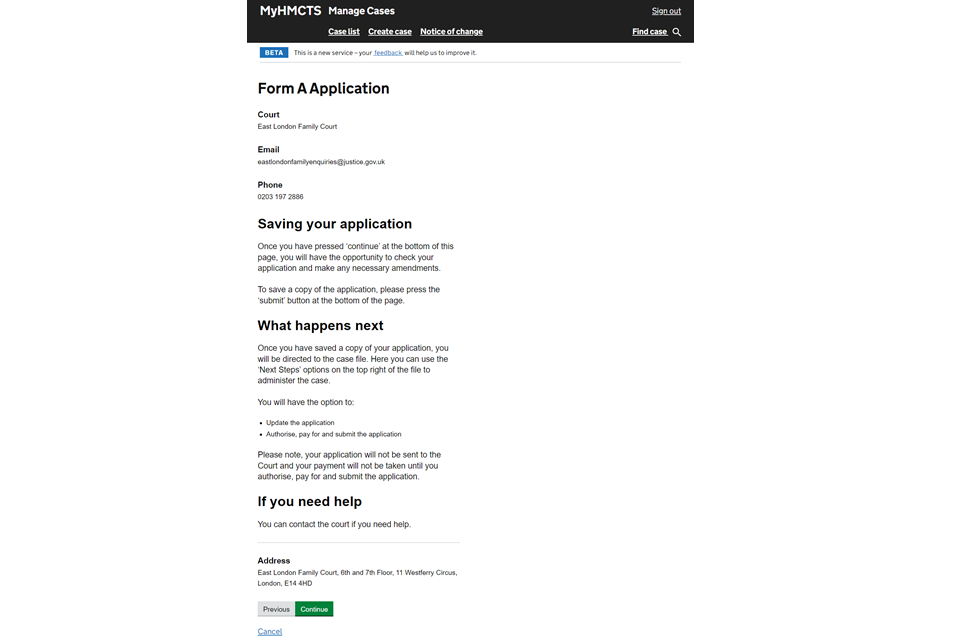
If you select ‘Interim child periodical payments’, you must lodge a D11 application before the court can list the interim hearing.
7. If you select ‘Periodical Payment Order’ you will need to answer additional questions. See steps 6 and 7 in Nature of application.
8. If the application is suitable for fast track, choose the reason why.
9. Complete the complexity questions.
10. Select the court details and whether the applicant needs any assistance or special arrangements when attending court.
11. Answer the questions about mediation and enter the mediation certificate details.
12. If you need to upload any documents, select ‘Add new’ and browse to add them. Then select ‘Continue’. If you are asked to upload any documents that are not applicable, upload a blank document to continue.
13. You will see the details of the court that will be hearing the case and some information about what happens next.
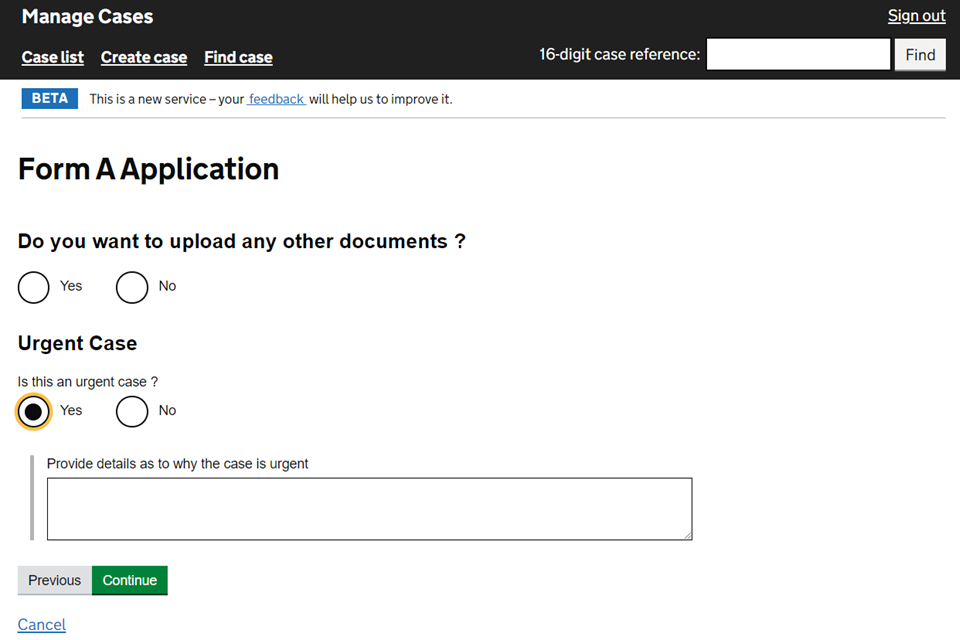
14. Select ‘Continue’ to check your answers and submit your application.
18. Application for enforcement
To add a confidential application, you must use the upload case files function and select ‘Confidential’.
You must email the court to tell them that the application has been submitted as a case file because of confidentiality.
Applications for enforcement of orders made on the portal must be made on the existing case by using the general application function.
You must upload the application, any draft orders and supporting documents in PDF format.
1. Select ‘Create General Application’ from the next steps dropdown list. Then select ‘Go’.
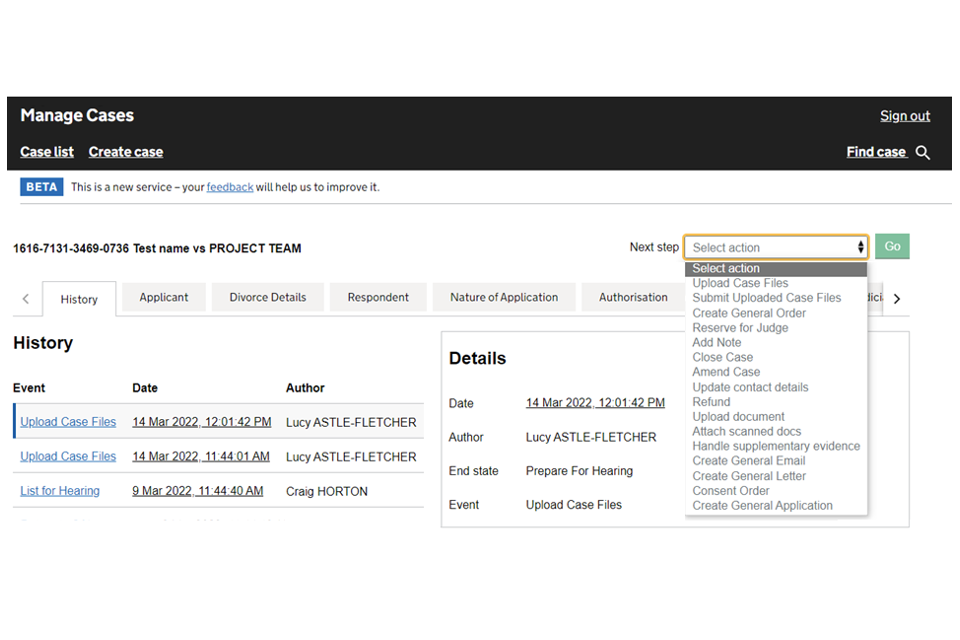
If previous applications on the case are listed, you must not overwrite them.
2. Select ‘Add new’ to create a new general application.
3. Select ‘Applicant’ as the person applying.
4. Select ‘Yes’ if you need a hearing. Enter the amount of time you estimate you’ll need for a hearing and, if required, any special measures needed from the court.
5. Select ‘Choose file’ to upload the general application.
6. Select ‘Continue’.
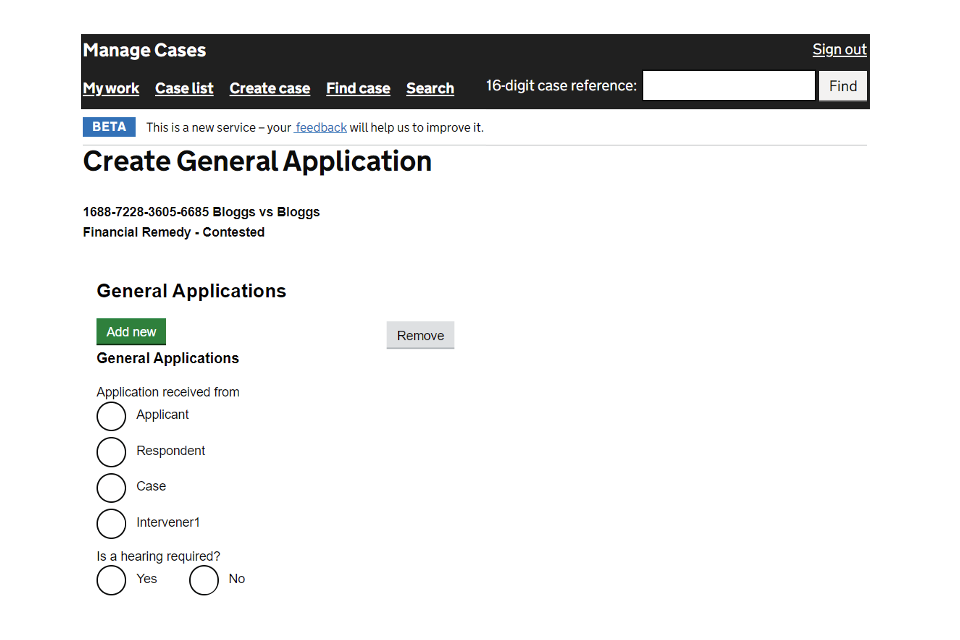
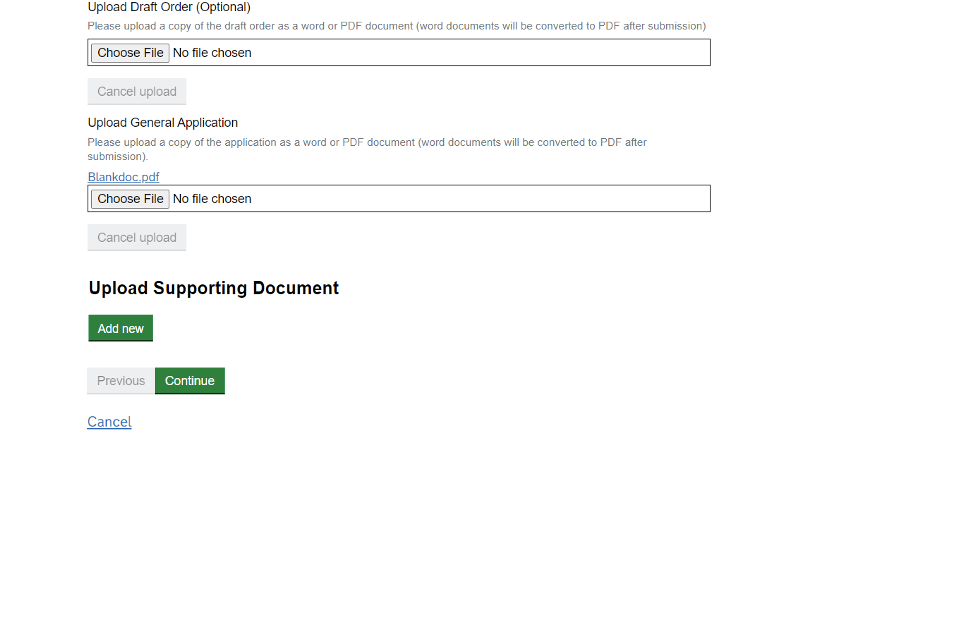
7. If appropriate, you can add an event summary and description. Select ‘Submit’.
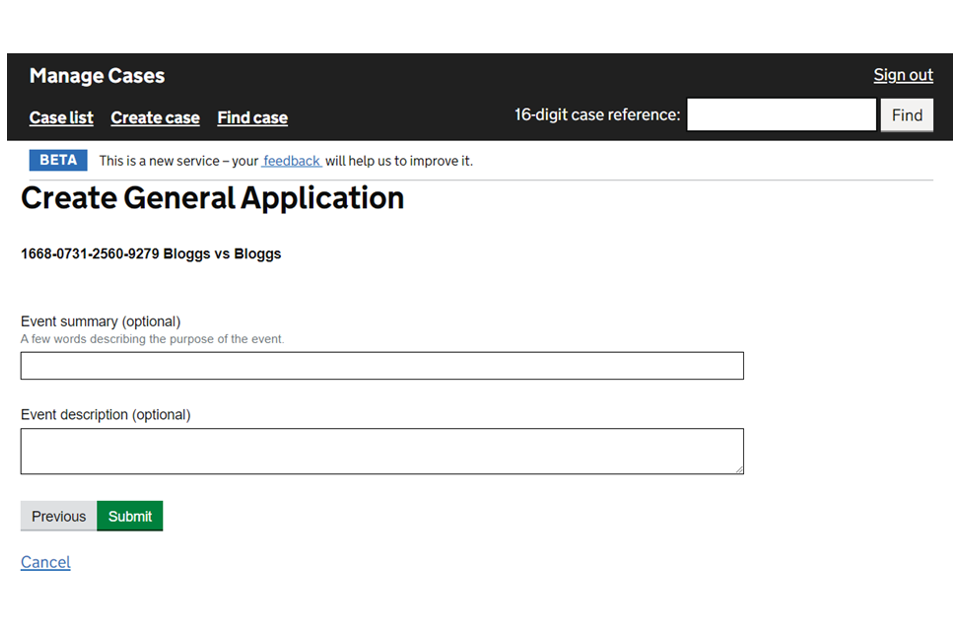
The court is notified when you submit your application. If required, they will contact you to arrange payment.
8. When the judge has considered your application, you will be able to view their comments in the ‘General Applications’ tab, under ‘Outcome details’.
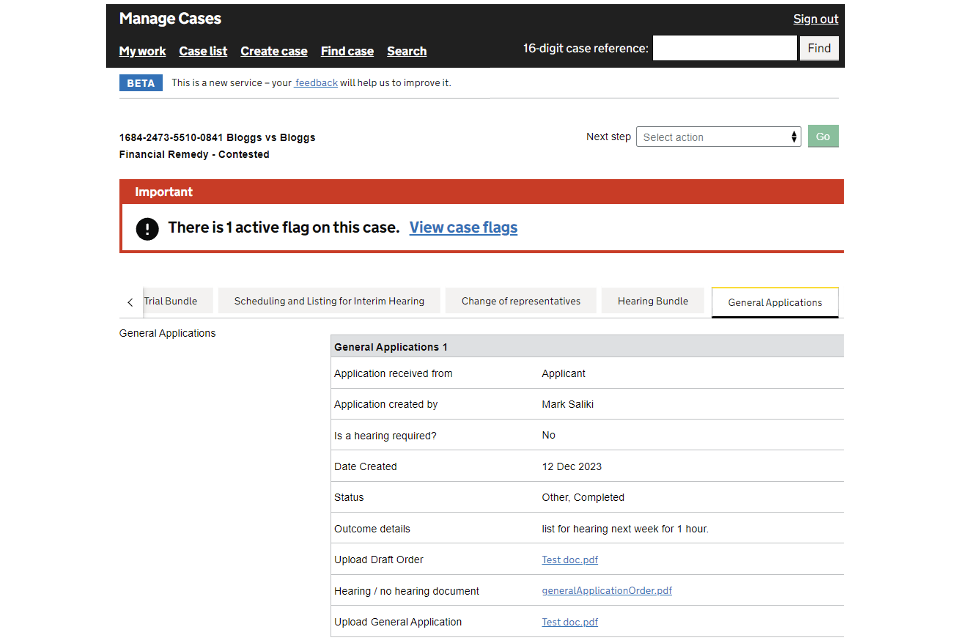
You will receive a copy of the application, any draft order and the court’s directions in the post.
You can ask the court to remove your application if:
- it has been filed by mistake
- you wish to withdraw your application and no action has been taken on the case
19. Apply for financial relief after an overseas divorce
Applications for financial relief after an overseas divorce must be made using form D50F. Applications for permission to apply must be made using form D50E.
Your application must be lodged with your local financial remedy court with a copy of form A.
The court will issue the application on the portal. If the application is approved by a judge and listed for a hearing, the parties will be told to access the case online.
20. Share a case
Once your application is submitted you can share it with others in your organisation. They can update the case and respond to orders on your behalf. Cases that are ineligible for sharing have their checkboxes faded out.
1. Check the box next to the relevant case(s).
2. Select the ‘Share case’ button at the top of the screen.
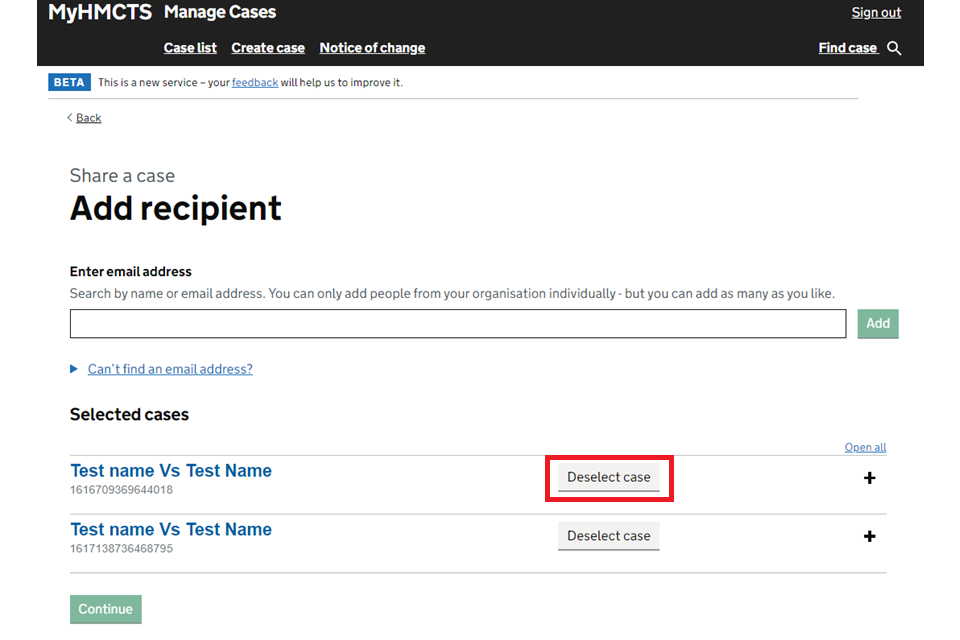
3. Enter the email address of the user you want to share the case with.
4. You can only share with one user at a time.
5. There is no limit to the number of people you share the case with.
6. Repeat this step for every person you want to share with.
7. You can check the cases you want to share and ‘deselect’ any you no longer want to share.
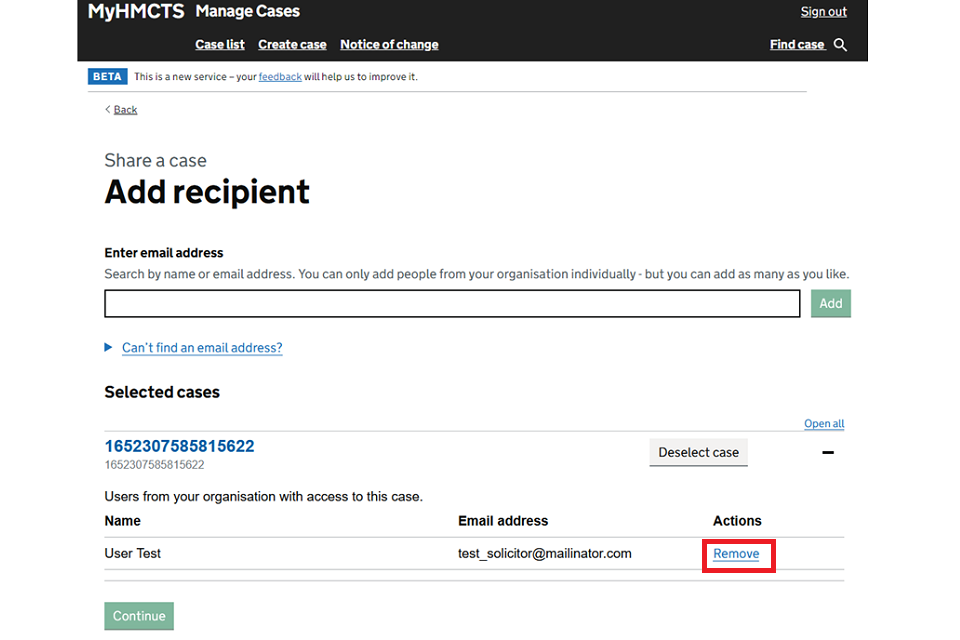
8. When you have finished adding the users you want to share the case with, select ‘Continue’.
9. You can remove someone’s access to a case by selecting ‘Remove’ next to their name.
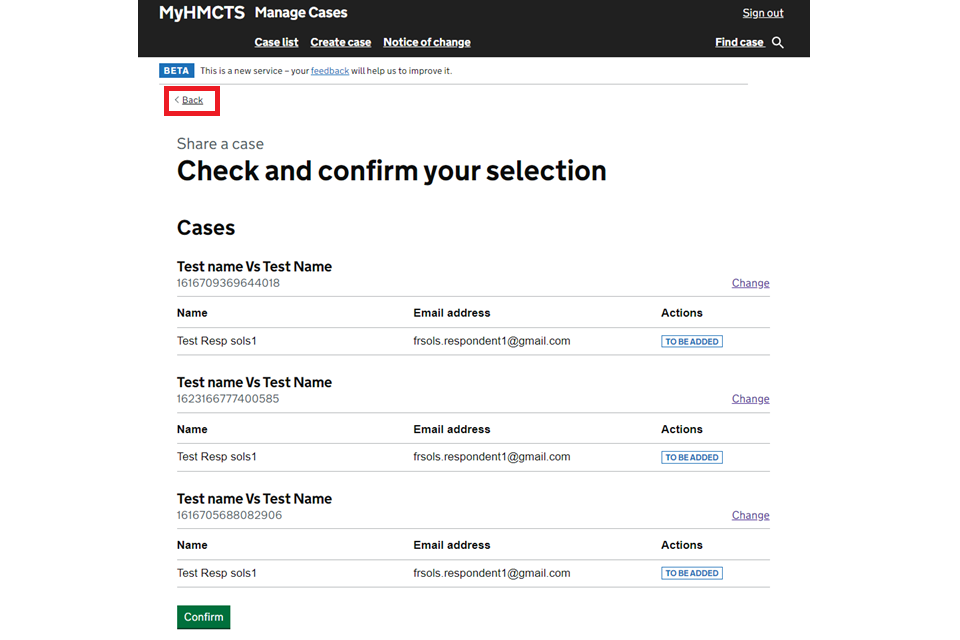
10. Once you have chosen the people you want to share the case with, select ‘Confirm’.
11. If you are not happy with your selection, choose to go ‘Back’ at the top left of the screen that takes you back to the previous screen.

12. You are taken to the final confirmation screen.
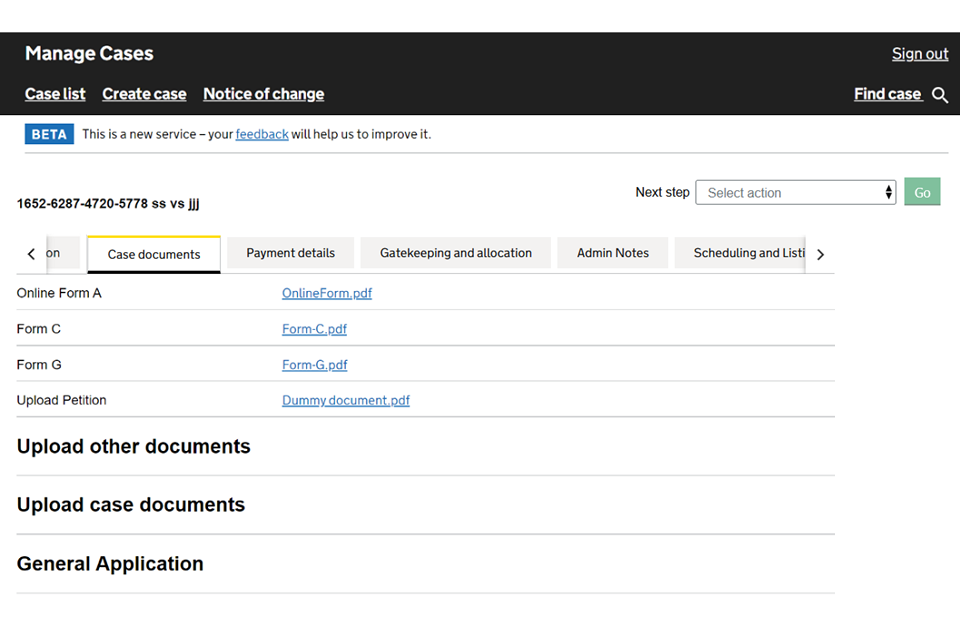
21. Get help with MyHMCTS
Managing cases and case access in MyHMCTS
If you need help with your case, contact the financial remedy centre (FRC) managing your application. Find the contact information at HMCTS Financial Remedy Centres.
If you see an error message in MyHMCTS that you cannot resolve, or if you have feedback on how we can improve, contact the HMCTS Financial Remedy Service Team at HMCTSFinancialRemedy@justice.gov.uk.
Find guidance for case administration tasks in MyHMCTS
Accessing your MyHMCTS account
If you are having trouble accessing MyHMCTS, make sure you are using the correct link. To manage a case, you must use https://manage-case.platform.hmcts.net.
You should also make sure you:
- check your internet browser is up to date – we recommend you use Google Chrome or Microsoft Edge (you cannot use Internet Explorer or Apple Safari)
- clear your cookies and your cache
- check your firewall and security settings
We recommend that you bookmark or favourite MyHMCTS in your internet browser. You should only create the bookmark or favourite once you have signed in and are on the homepage. Do not create it from the sign in or verification pages, or while you have a case or organisation open.
If you are still having trouble accessing MyHMCTS, try using a different device to sign in.
If you have an IT support team, they will be able to help with any device, browser and security issues.
If you have an issue with your MyHMCTS account, you should contact an account administrator in your organisation.
If you need additional support with your MyHMCTS account, email MyHMCTSsupport@justice.gov.uk. We aim to respond within 5 working days.
